FAST DENTURES
204-947-1807
MINERALS, ENERGY AND TRANSPORTATION

The pillars of Premier’s plan to rejuvenate Manitoba

Page 7
Winnipeg pharma leader, Manrex Ltd., celebrates 50 years of global business

Founded in 1973, in Winnipeg, by John H. Webster, Manrex Ltd., was one of the first companies to introduce bubble-pack medication packaging for nursing homes and home care to the global marketplace. You’ll likely recognize these bubble packs if your senior family members receive their medications in bubble packs from their pharmacy. Their mission is to “Help health care providers save lives by eliminating medication errors” and their vision is “To be the leading provider of innovative and diverse medication error prevention products that increase customer efficiency and provide them with more time for patient care.”
John H. Webster (founder of Manrex-Pharmaceutical Consultants Inc.) immigrated in 1953 to Canada from Scotland where he’d apprenticed as a pharmacist. Unfortunately, when he arrived in Canada, they did not recognize his credentials, so he found work in sales with a couple of pharmaceutical companies.
Kathleen Richardson, C.C., O.M., LL.D. inducted into Citizens Hall of Fame
André Lewis, RWB Artistic Director & CEO
Atrue proponent of the arts and well-known philanthropist, the late Kathleen Margaret Richardson was a treasured partner of Canada’s Royal Winnipeg Ballet (RWB) for decades. She was family. Her death in September 2019 deeply resonated
A Collection of Culinary Memories
Pegasus publishes new cookbook by our own Ian Leatt
within our walls, the Winnipeg arts community and well beyond.
On June 27, 2023, Kathleen Richardson was inducted into the Winnipeg Regional Real Estate Board’s Citizens Hall of Fame. When the beautiful bust sculpted by Madeleine Vrignon was unveiled, those of us gathered at the Assiniboine Park Pavilion, including several members of the Richardson family, truly felt Kathleen’s presence among us in spirit. The
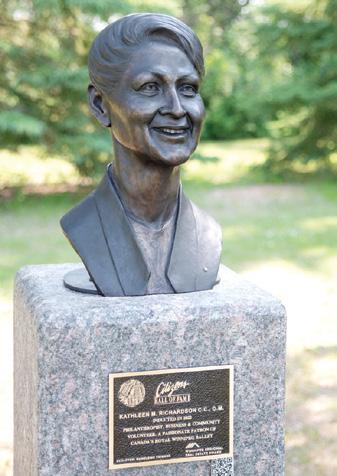
For many years, our own Ian Leatt, a trained chef, has been offering a delicious recipe in every edition of Lifestyles 55. Now you can get a collection of these wonderful treats in his cookbook, A Collection of Culinary Memories.


Ian grew up on Jersey in the Channel Islands. His grandmother had a profound influence on his early life and many of the recipes are drawn from those early experiences. Every recipe is preceded by a memory, making the book a very personal journey.
It is not just a journey back in time though, it is a journey through time. In Ian’s inimitable way, the book reflects his personal style, and he has turned it into a culinary calendar. The recipes are presented by season, along with his favourite
August 2023 whatsupwinnipeg.ca
Dorothy Dobbie
10 ‘Kathleen Richardson’ u 7 ‘Culinary Memories’ u
Mayor Scott Gillingham helps commemorate Manrex's 50th anniversary with the three shareholders of the company.
4 ‘Manrex Ltd.’ u
Bust of the late Kathleen M. Richardson, C.C., O.M., LL.D.
IF YOU ARE A SENIOR. . . . . . You should consider having the following in place

Will
The preparation of a will may seem like a daunting task, however, it is essential to ensure that your property is disposed of according to your wishes upon your death. If you pass away without a valid will, the law states what is to happen to your estate.
Power of Attorney
A power of attorney is a document which appoints an individual to handle your affairs in the event you become mentally incapable of making your own decisions. Nothing prevents you from continuing to make your own decisions while you are still competent.
A power of attorney is an extremely valuable document to have in place in case anything happens to you which affects your mental ability, such as a stroke, coma or dementia.

Health Care Directive (Living Will)
A health care directive, commonly called a living will, is a document which appoints an individual to make decisions with regard to your health care only, while you are alive but unable to express your decisions yourself. This document is distinct from a power of attorney and deals only with health care decisions such as whether life sustaining treatments, such as CPR or blood transfusion, should be continued or withdrawn.

Don’t want to miss a single issue of Lifestyles 55?

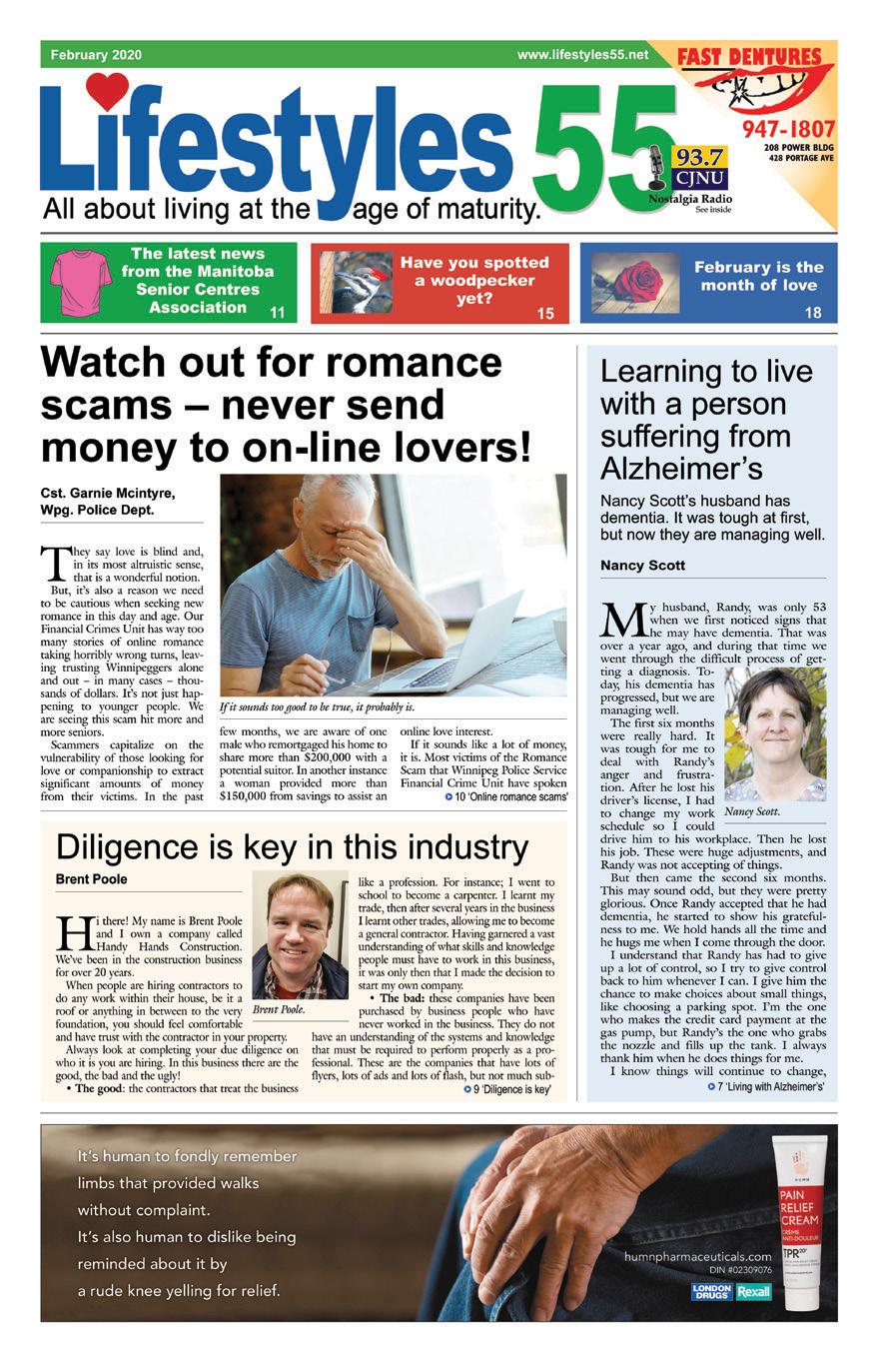


*Plus
Home
*Plus
- Rates are per person.
visits are $250.00* (includes both meetings)




2 whatsupwinnipeg.ca August 2023 1-800-265-0027 • info@bgpgroup.ca • https://www.bgpgroup.ca HALO-LED™ The all new HALO-LED™ is the industry’s first LED in-duct, whole home air purification system that is both mercury free and zero ozone compliant. The HALO-LED™ proactively treats every cubic inch of air conditioned space, thereby reducing airborne and surface contaminants and pollutants. By combining REME-LED™ UV technology along with RGF’s proven PH-CELL® and REME® technologies, the HALO-LED™ provides revolutionary indoor air purification. Breath easier today - for more info call 1-800-265-0027 For full test results on the air purification systems: https://www.rgf.com/test-results/ Check out this video of RGF’s HALO-LED™ whole-home air purification system: https://www.youtube.com/watch?v=_FCFF9Uj3Zk
in your house?? Take control of the indoor air in your home or workplace by cleansing it from unwanted airborne pollutants like forest fire smoke, viruses, bacteria, mold, dust, odours and pollen. Breathe easier today – you can with the help of BGP! BGP Environmental Group introduces the latest in air purification technology with proven test results! TACIUM VINCENT & ASSOCIATES 206 St. Mary’s Road, Winnipeg, MB R2H 1J3 DAVID G. VINCENT (204) 989-4236 www.taciumvincent.com
Smoke in the air - smoke
Standard Fees* Seniors Last Will and Testament $225.00 $200.00 Power of Attorney $175.00 $150.00 Health Care Directive $ 75.00 $ 50.00
plus GST and PST -
and hospital
(includes
meetings) *plus GST and PST Will and Testament $275.00 Power of $225.00 $125.00 $100.00
*
Rates are per person. Home
visits are also available $250.00*
both
PST
GST and
hospital
and
GST and PST. q $36.00*, 12 issues q $72.00*, 24 issues *Plus applicable taxes q Cheque q VISA q Amex q MasterCard Card No Expiry ........................ Signature Name Address City................................. Prov............ Postal Code ....................... Telephone...................................... Fax.......................................... Connect with us online: whatsupwinnipeg.ca | Facebook: Lifestyles55 | Twitter: @Lifestyles55
Call us at 940-2700 and ask Shelly, she will be only too pleased to help you purchase a subscription that will bring the paper right to your doorstep! Shelly can arrange for a small monthly charge to your credit card. Or you can start by filling out and mailing in this form to: Lifestyles 55 c/o Pegasus Publications at 138 Swan Lake Bay, Winnipeg, MB R3T 4T8
Follow us online at: whatsupwinnipeg.ca
Facebook: Lifestyles55 Twitter: @Lifestyles55

PUBLISHER
Pegasus Publications Inc.
EDITOR
Dorothy Dobbie dorothy@pegasuspublications.net
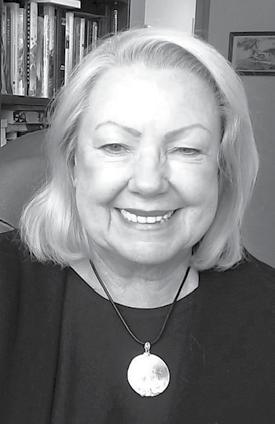
ART DIRECTOR
Karl Thomsen karl@pegasuspublications.net
GENERAL MANAGER
Ian Leatt ian.leatt@pegasuspublications.net
CONTRIBUTORS
Gary Brown, Tim Chapman, Romel Dhalla, Dorothy Dobbie, Rick Duerksen, Hon. Myrna Driedger, Stefano Grande, Hon. Scott Johnson, Jim Ingebrigtsen, Hon. Kevin Klein, Myron Love, Jo Magnifico, Fred Morris, Trudy Schroeder, Sherrie Versluis, Wayne Weedon, Robert Wrigley.
Canadian Publications mail product Sales agreement #40027604
ADVERTISING
1-888-680-2008 info@pegasuspublications.net
SUBSCRIPTIONS
If you would like to receive Lifestyles 55, we offer both monthly newspaper and online formats.

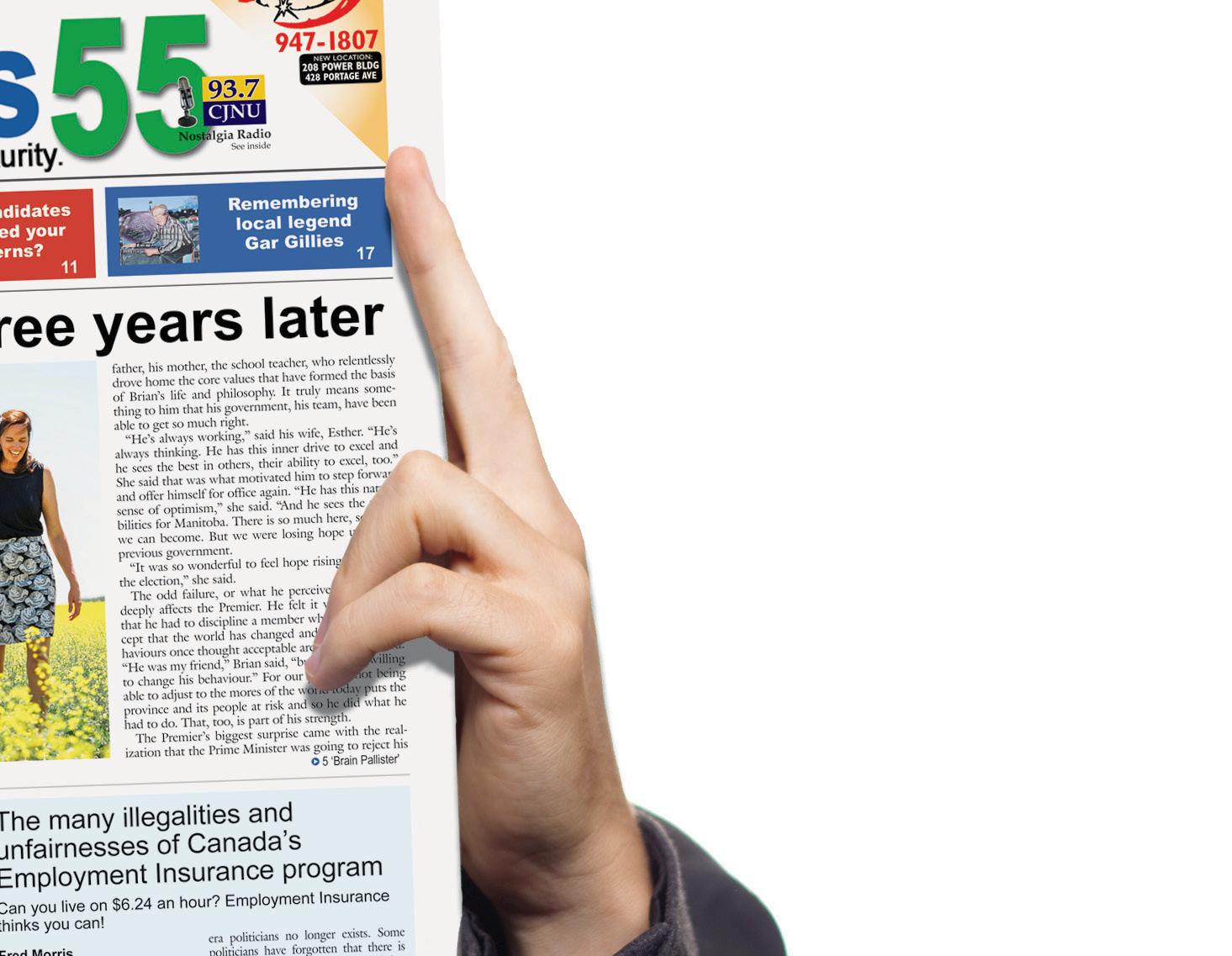



To place your order, call 204-940-2700. Subscriptions are $48.00 per year, plus tax. American Express, MasterCard, Visa and cheque accepted. To view a back issue online visit lifestyles55.net

Published monthly by:
Pegasus Publications Inc.
138 Swan Lake Bay, Winnipeg, MB R3T 4T8 204-940-2700 whatsupwinnipeg.ca
DISTRIBUTION
Available at over 100 locations from Winnipeg, Brandon, Steinbach, Morden, Selkirk, Flin Flon and The Pas. If you would like bulk copies of this publication, contact Ian Leatt at (204) 940-2707 or ian.leatt@pegasuspublications. net. Also available digitally at whatsupwinnpeg/ lifestyles and on Facebook: Lifestyles55
EDITORIAL SUBMISSIONS
Call Dorothy Dobbie at (204) 940-2716 or email dorothy@pegasuspublications.net for more information and guidelines.
Any opinions expressed in columns by our contributors are their own opinions entirely and are not necessarily shared by Pegasus Publications Inc. All information presented by the contributors is the responsibility of the writers.
Lifestyles 55 is published monthly. Reproduction in part or in whole is prohibited without seeking permission in writing from the publisher.
Copyright Pegasus Publications Inc.
It is time to digitize our world
According to Cisco, the leading manufacturer and vendor of networking equipment and digital communications technology, in its June 2023 Digital Readiness Index report, Manitoba is lagging behind other provinces and territories in the technology field. We are number 8 among. Even the Yukon scores higher at number 6.
The feds aren’t all that much better, ranking 17th out of 167 digitalized countries around the world, this despite announcing a $3.2 billion spending effort in 2019 that seems to be focusing on just getting highspeed Internet to Canadians. According to its own map, the program is concentrated in high population areas, with remote communities still waiting. Number one is BC’s lower mainland.
As it stands, the federal government’s efforts may soon be obsolete thanks to Elon Musk and his Starlink program which is already providing reliable service to customers in remote locations.
However, Internet service is only one immediate first step towards what is required. We need interconnectivity between all the pockets of digitalized information that is already in the public domain, but not now properly protected. That includes your health information which currently resides in countless computers but is not interconnected even within the system, so it is virtually useless.
And expensive.
Why expensive? Consider just one of the many issues. You go for a blood test to one department which diagnoses an issue and sends you to another department. They do another blood test because the information from the first test is not available to them. More time, more equipment, more money.
Or how about the story on CBC recently about a woman whose father died suddenly. The family asked for a copy of the diagnosis to help them deal with their grief but was told it would be faxed to her. She said she didn’t have a fax machine, could they just send it by email. Oh, no, was the answer. We aren’t allowed to do that! Stupid, right? Private no! Back when my company had a fax machine, we often received medical records from one of the local hospitals by mistake. Our Fax number was apparently close to that of the nursing home they were contacting.
I can feel the vibration from all those who are disagreeing with me, shouting the need for privacy, and how nobody should have access to these records but themselves and their doctor and, anyhow, how safe is the Internet? It gets hacked all the time. And share your financial information? Never!!
Well, folks relax. Step back. Take a look at the big picture. Most of you already do Internet banking and most of you fill out your taxes online. You shop online and your credit card or banking information is shared with a private company. If you shop at Costco, you share more than just your credit card information, you are sharing your shopping preferences and habits. Get a parking or a speeding ticket? You can connect and pay the city online, not to men-
tion paying for your monthly utilities. Most of you also are already registered with Manitoba Shared Health who have a lot of your health information from COVID-19. Remember that little Manitoba vaccine card you got? If you travel, all that information is already lodged in your passport and or NEXUS card.
Making the connections
The next step is connecting and linking all this info and more across the country, but at least let’s start with Manitoba. It is possible to do it all and save your privacy. Let me tell you the story of the little country of Estonia, only 1.3 million strong, the same population as our province, but one of the most advanced digitalized countries in the world. Estonia, by the way, created Skype, the first “face time” program.
All the country’s government services have been linked digitally across one platform, safely. The system includes education, justice, healthcare, banking, taxes, even voting – it is all there, accessible across the platform.
Here is the secret. While everything you can think of is online and accessible to users, data is not centrally held. The data platform instead links servers through encrypted pathways. Your doctor’s office would keep its own data, for example. When information is requested, it is sent securely through that encrypted pathway to the authorized requester. The system has been likened to blockchain but according to the innovators, it is not blockchain technology, but it is similar and offers the same immediate visibility of any attempted data breach. There is also a backup server to safeguard the system in the event, despite everything they do, that a breach occurs.
The Estonian system covers everything – even self-driving cars, but they have been at it for 15 years. We have a long time to go before we get to where this country is but on the other hand, we will never get there if we don’t start. And we can shorten our start up times using lessons they learned and by using the technology they designed. For Manitoba, the first thing we should connect is our health care system. In Estonia, digitalization has had a powerful effect on health care, freeing up physicians and health care practitioners in a myriad of ways. Not only that, but it provides better outcomes because all the expert advice can be brought together in one place. Pharmacists can quickly alert doctors about medicinal conflicts, dentists, ophthalmologists, psychiatrists, physical therapists, can see the whole patient at any given time and more quickly diagnose big problems.
And of course, it reduces all that duplicated and burdensome paperwork that is keeping docs from seeing patients. Administrators, unions, and health practitioners all need to come on side with this and help steer the reforms. This is not a political issue. It is something any government, no matter what their political stripe, should take seriously and start thinking about how it will be rolled out. Our health depends on it.
August 2023 whatsupwinnipeg.ca 3
ISSUES IN THE NEWS
Like it or not, Manitoba, it is time to digitize our world. It is either that or slip into obscurity.
Pre-order a tasty copy for yourself at a special reduced price of only $25.00 for a limited time only! Plus taxes and shipping. For every copy sold through Veseys, Pegasus and Veseys will donate one dollar to the Food Banks Canada organization. A Collection of Culinary Memories, a new cookbook from our resident foodie Ian Leatt featuring 196 pages of nostalgia-fueled recipes is coming soon! Call Erica at 1-888-680-2008 to reserve your copy! Sponsors: Veseys Seeds Ltd. Advertise in To book your ad contact Ian at (204) 940 2707 or ian.leatt@pegasuspublications.net and get noticed!
Dorothy Dobbie
Deserving 12 new Orders of Manitoba
Congratulations to the 12 Manitobans who received the Order of Manitoba, the province’s highest honour, on July 20, last month.
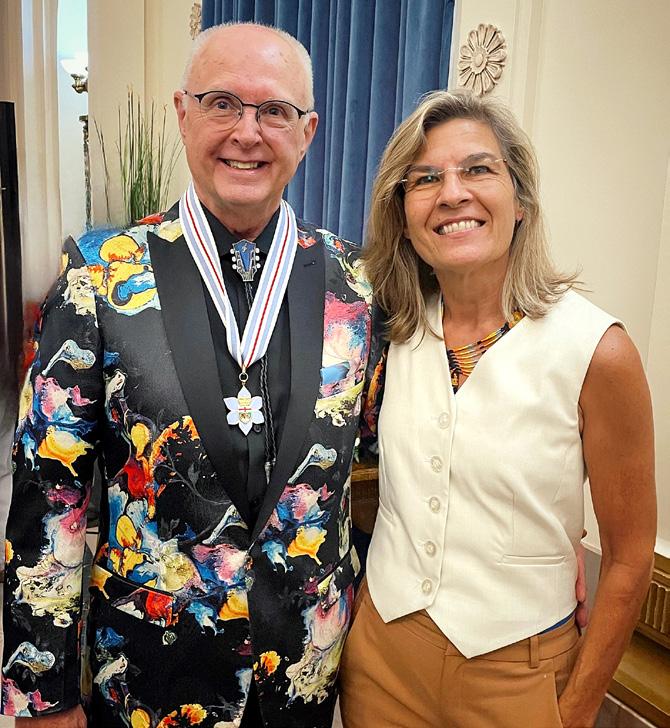
The Order of Manitoba was established in 1999 to honour Manitobans who have demonstrated excellence and achievement, thereby enriching the social, cultural or economic well-being of the province and its residents.
“The 12 outstanding Manitobans being invested into the Order of Manitoba this year are leaders, visionaries and mentors committed to building community,” said Lt.-Gov. Anita R. Neville. “Today’s investees represent the very best of our province, and it is a pleasure and privilege to recognize and celebrate them.”
Appointments to the order are made by the chancellor based on the recommendations of an advisory council. Order of Manitoba members are entitled to use the initials O.M. after their names for life. The list of all members of the Order of Manitoba is on permanent display in the Legislative Building.
Mr. Jamie Brown. Jamie Brown has served as the CEO and executive producer of Frantic Films since 2000. In these roles, he has helped build one of Manitoba and Canada’s most successful film and television companies. Winning awards in Canada and abroad for his innovation, creativity and business leadership, he is a tireless community volunteer and an advocate of Manitoba’s creative sector.
Mr. David (Ace) Burpee. From Cooks Creek, Manitoba, David “Ace” Burpee is the widely recognizable host of The Ace Burpee Show on 103 Virgin Radio. A tireless volunteer and mental health advocate, he has championed countless charitable causes and people across the province, using his platform to continuously raise awareness, support and funds for worthy causes.
Mr. John Einarson. A former award-winning high school history teacher, John Einarson is a widely respected broadcaster and rock music historian. He is the author of more than a dozen critically acclaimed music biographies and contributed to A&E’s Neil Young Biography episode and CBC’s The Life & Times of Randy Bachman.
Mr. Charles Huband (the late). The late Charles Huband was an accomplished lawyer, judge, political leader and community activist, having lent his time and talents to important causes in the community for over 60 years. He was instrumental in the creation of Prairie Theatre Exchange over 50 years ago and was the cofounder of the Westminster Housing Society.
The Honourable Janis Johnson, C.M. Janis Johnson served in the Canadian Senate for over 25 years,
making her longest serving Manitoba senator. An advocate for both the cultural sector and women’s health and education, she contributed to the founding of the Mature Women’s Health Clinic (now the Women’s Health Centre) and founded the Gimli Film Festival. She chairs the Valuing the Icelandic Presence Committee at the University of Manitoba and assisted in the development of Qaumajuq. Janis has been a lifelong supporter of Manitoba and its relationship with Iceland.
Ms. Terumi Kuwada. A retired social worker and dedicated community volunteer, Terumi Kuwada has been a strong advocate in the areas of human rights and social justice for more than 35 years. Her longstanding commitment to human rights and promoting respect and understanding between ethnic groups is illustrated through her work with many organizations including United Way Winnipeg and the National Association of Japanese Canadians.
Dr. Lorrie Kirshenbaum. One of Canada’s most prominent scientific leaders, Dr. Lorrie Kirshenbaum’s pioneering research on cardiac cell death has transformed cardiovascular care worldwide. He has earned an international reputation for research excellence and is best known for his work in understanding why the cells of the heart die after a heart attack and in cancer patients undergoing chemotherapy.
Dr. Gerry Price. An accomplished business executive and philanthropist, Gerry Price is chair and CEO of Price Industries Limited, one of the province’s largest private employers. Dr. Price and his family support charities and capital campaigns in Manitoba across many areas including children and families, youth mentorships, education and scholarships, health care and other community-led initiatives.
Ms. Alvina Rundle. A community advocate for Lake St. Martin and beyond, Alvina Rundle is dedicated to helping Indigenous people involved in the justice system. She was instrumental in establishing courts in remote Indigenous communities and recruiting court Elders to serve, while also providing language interpretation services and sentencing assistance to respective case judges.
Dr. Richard Smith. Dr. Richard Smith is a Manitoba family physician who has dedicated most of his 52-year professional career to saving lives and advocating for those impacted by the HIV/AIDS epidemic in Manitoba. He is a leader in the provision of clinical excellence to people often ostracized for their sexual orientation or lifestyle, and established the Village Clinic, which eventually became the Nine Circles Community Health Centre.
Ms. Elaine Stevenson. For more than 30 years, Elaine Stevenson has been a dedicated, effective advocate for children, youth and adults with eating disorders. Inspired by her own personal tragedy of losing her daughter to an eating disorder, she co-founded the Alyssa Stevenson Eating Disorder Memorial Trust, with a mission to bring about essential change in the care and treatment of eating disorders in Manitoba and across Canada.
Mr. Amarjeet Warraich. Amarjeet Warraich is a community leader and advocate, particularly in the provision of support to new Indo-Canadian citizens. During his tenure as commissioner of Manitoba’s Human Rights Commission, he oversaw a period of landmark new initiatives in the province including the proclamation of the Manitoba Human Rights Code in 1988, and measures respecting the rights of women, people with disabilities, Indigenous peoples and the LGBT community. He has long been a special friend to the publisher of Lifestyles and we congratulate him for his work on restoring the old Maryland Hotel which is now the Econo Lodge.
The Order of Manitoba Advisory Council relies upon nominations from the public. To nominate a deserving Manitoban for the 2024 Order of Manitoba, visit www.manitobalg.ca.
u Winnipeg pharma leader, Manrex Ltd., celebrates 50 years of global business
Continued
After being in the country approximately 10 years he was promoted to National Sales Manager for an organization called National Drug in Manitoba, which after many mergers and acquisitions is now called McKesson Canada. He was responsible for bringing many products to the pharmacy marketplace.
He wanted to introduce the “bubble packs” but the higher ups didn’t think it would ever be accepted.
John H. believed so much in the product that he left to start his own business, Manrex Ltd, focused on medication management. The nurses and nursing homes loved the Manrex Controlled Dosage System, but initially there was push back from pharmacy because it was a dramatic change in the way things were done. As the consummate entrepreneur and salesman, John H. brought a pharmacist on board to drive sales. They began servicing nursing homes until such time as the pharmacies saw the value in providing these services. Once there was buy-in, Manrex removed itself from the provision of pharmacy services to focus on the development of its offerings. The Manrex Controlled Dosage System ultimately became the system of choice for long term care in Canada, the United Kingdom and Australia.

Manrex successfully transitioned to second generation in 1991, when siblings Fiona Webster Mourant and John L. Webster purchased the company. They began introducing other product lines to the Manrex portfolio and grew the company to 10 times the size it was at acquisition. Today, in 2023, they are proud to say they are moving to third the generation with Wade Mourant becoming a shareholder.
It is important to note that Manrex has always serviced its global customers from their head office
which has been in Winnipeg since its inception in 1973. “We were very privileged to have the Mayor of Winnipeg, Scott Gillingham, visit our facility to help celebrate our 50th anniversary and present Manrex with a Community Service Award. We are very honoured by this recognition.” Said Manrex president, Fiona Webster Mourant.
Manrex is a global company with successes across Canada as well as in Ireland, the United Kingdom, France, Spain, Portugal, Germany, the Netherlands, Australia, Hong Kong, South Korea, and the United States.
Manrex has always been recognized as an innovator in bringing new technologies to the Canadian marketplace. Manrex was involved in introducing the first computer systems into pharmacy, the first electronic
medication administration records (e-mar), automated pill counters, automated dispensing cabinets in hospitals, automated multi-dose packagers, automated pouch verification systems, 24/7 prescription self retrieval systems, pick-to-light-will-call systems, drug inventory management systems and automated in-home medication dispensers. While many of these products are now commonplace these introductions to the market by Manrex Ltd. have had a positive impacted on the pharmacy industry and on medication adherence.
Other proprietary Manrex product lines include their market leading ergonomic, height adjustable medication delivery carts and medication crushing devices such as the automated PowderCrush (which reduces repetitive strain injuries for nurses). Both product lines are for use in nursing homes. Manrex also supplies automated pill counting devices for use in pharmacies. “We are very proud to say that these proprietary products are all manufactured and assembled here in Manitoba,” said Fiona Webster Mourant.
Manrex and its team members have received various awards throughout the years including Outstanding Manitoba Ambassador of the Year by the Manitoba Chambers of Commerce; Family Enterprise of the Year for Manitoba by the Canadian Association of Family Enterprises; Manitoba Woman Entrepreneur of the Year-International Trade & Overall Categories (Fiona Webster Mourant) and were finalists in the Canadian Woman Entrepreneur of the Year Award and the Ernst and Young Entrepreneur of the Year.
Is your Manitoba company celebrating a remark able milestone? We would love to hear from you. Call Dorothy Dobbie 204-940-2716 or email me at dorothy@pegasuspublications.net

4 whatsupwinnipeg.ca August 2023
Jon Einarson with Lisa Lewis.
from
1
page
John Webster (centre), with his kids John L. Webster and Fiona Webster Mourant who took over the business.
Lies our teachers tell us
To pass an exam, students are told they must learn “facts”. Teaching is based on feeding “facts” to students and then having them regurgitate “facts” back so the teacher may assess their students’ ability to learn. However, nothing teachers present to students are facts. What is being taught are opinions and theories. Author and educator, Neil Postman, suggests schools should tell the truth, that all “facts” are arguments. Postman suggests schools should have students look for evidence to prove or dispute “facts”. Students could be graded on their research and students would learn very valuable life lessons, such as, nothing can be referred to as fact, and everything must be questioned. Students would go out into the world with a better ability to discern when people are telling the truth and when they are not. Students will get into the habits of questioning everything and researching the pros and cons of any argument. They would be less prone to be being taken advantage of by scammers. For hundreds of years schools have taught that in 1492 Columbus discovered America, despite considerable contradictory evidence. Historians suggest 1492 was not the first time Columbus sailed to the Americas. Evidence indicates he sailed to Newfoundland in 1482 as a cabin boy on a Portuguese ship. There is evidence which indicates Columbus, on his 1492 voyage, had a Portuguese map which clearly showed where South America is situated. Apparently, this map was copied
from a Chinese map. Historians tell us Columbus and explorers who followed him found people already living in the Americas, some of whom were speaking a Chinese dialect. Historians also tell us, Chinese sailing ships circumnavigated North and South America long before Europeans knew of these continents. Wrecks of Chinese ships, which date back over 500 years, have been found in California. Why are schools not teaching contradictory evidence about Columbus?
Wayne Weedon Food for Thought
There are many stories which depict Mother Teresa as a wonderful and charitable saint. Christopher Hitchens disagreed with this image. He painted Mother Teresa as being sadistic and demonic, and he denounced her in his book, The Missionary Position. Mother Teresa’s supporters simply ignored Christopher Hitchens. They did not condemn his book nor bring libel charges against him. Why? What is the truth about Mother Teresa?
Because the Infallible Church accused Joan of Arc of being a heretic, they condemned her to be burned alive while tied to a wooden stake. For hundreds of years many French citizens protested that her execution was unjust. To them, Joan of Arc was a hero who should have been honoured. To silence the public outcry, the Infallible Church did a flip-flop, they canonised Joan of Arc as a saint. Which of the popes was infallible, the one who condemned Joan of Arc to death or the one who made her a saint? Or maybe neither one was?
In 1960, when John Diefenbaker, Prime Minister of Canada, presented Canadians their new bill of rights, he stated, "I am Canadian, a free Canadian, free to speak without fear, free to worship God in my own way”. During the 1970 October Crisis, Prime Minister Pierre Trudeau demonstrated that Canadians’ rights are not guaranteed, and our bill of rights is not worth the paper it is written on.
In its very first sentence, the Canadian Bill of Rights acknowledges the supremacy of God. The original bill sent to The House of Commons made no mention of God. Why was God added, despite the common knowledge that more than half the world’s population believe there is no God, or believe, in all probability, there is no God? Nobody has ever been able to prove the existence of God, or that God does not exist. We all have our own opinions.
Is Canada’s declaration of the supremacy of God an insult to atheists, agnostics, and anyone whose religion does not include God? Is Canada discriminating against non-believers? Teachers should be asking their students to do some research and find out why God was put into the Canadian Bill of Rights, and why only as an afterthought, not in the original bill sent to The House of Commons.
It is time for schools to begin encouraging their students how to think and to question what they are being taught. That is food for thought.
Next Month: War
Wayne Douglas Weedon is a Manitoba author who writes a combination of fictional and factual stories, essays, and novels.
Former garment industry leader keeps busy in retirement with philanthropy, exercise
For several years beginning in 1986 or 1987, I was a stringer for Style, Canada’s garment industry magazine. As such, I got to know most of the captains of industry in the trade here. And the individual who left the most indelible impression on me was Gary Steiman who, when I knew him, was president and CEO of Gemini Fashions of Canada, at one time one of Canada’s largest distributors of outerwear -with customers and suppliers from around the world.
I found Gary to be open, gregarious, and well-informed about trends in the industry. I could always count on Gary to leave me with a lot of good material for my articles. So, it was nice to be able to reconnect with Gary and find him, although long retired from business, still hale and hearty at 87.
Gary grew up in the north end. After high school, he decided to pursue a career as a chartered accountant. He graduated in 1958, at the age of 22, and quickly found work with the federal income tax department.
“My goal in going to work with the tax department was to learn taxation from the inside before pursuing my own entrepreneurial path,” he recalls.
In 1962, he struck out on his own, forming Monarch Management Ltd. to offer consulting services on taxes and estate planning. Steiman was invited by Ralph E. King Jr., an apparel engineer from New York, to go into partnership with him and rescue Canadian Garment Ltd., a troubled Winnipeg clothing manufacturer.
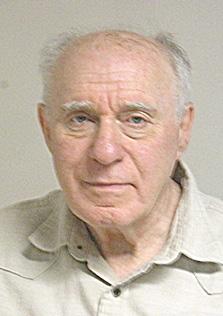
“At first, I turned him down,” Gary recounts. ‘My grandfather, Louis Steiman, opened one of the city’s first garment manufacturing companies in 1904, shortly after he came to Winnipeg. He produced buffalo coats for the police force and leather jackets and coats. I hated the smell of the leather, and the place was always noisy and dirty. I didn’t want to work in that kind of environment.”
But King persisted and Gary agreed to become an equal partner in the business along with King and Meyer Klapman. The deal was that Gary would work half time at the plant while continuing to operate his consulting business.
The problem for Gary with that arrangement, he remembers, is that every time he would drive by the factory, King’s car was always parked outside. “I began to feel guilty,’ he says. “Here was Ralph putting in these long hours. As an equal partner, I felt that I should be putting in equal time. So, I went all-in.”
Three years later, Gary and Ralph King also started their own company, Gemini Fashions of Canada Ltd. “Being a CA provided me with exposure to many different kinds of business,” he points out. “I could go in
any direction.” Meyer Klapman later became a partner in Gemini Fashions of Canada.
The new company initially produced ski wear (Gary has had a lifelong passion for skiing) and women’s outerwear. Later, Gemini added children’s outerwear to the mix.
A turning point came when Gary responded to a call to attend a federal government trade show for Canadian manufacturers in Toronto aimed at foreign buyers.
“There were 300 Canadian manufacturers at the event,” he recalls, “but just three were garment makers. Our first customer was Arnott and Company, a large department store in Dublin, Ireland. Mr. O’Leary, Arnott and Company’s president, placed an order for eight different styles of children’s outerwear consisting of 100 pieces in each style. Arnott became a regular customer of Gemini and recommended us to other European department stores that were part of an international association of department stores.
It was while Gary was serving as president of the Manitoba Fashion Institute, the industry’s central training and lobbying body in the province in 1989, that the Free Trade Agreement (FTA) between Canada and the United States came into effect.
“During the period between 1989 and 1995, our business grew eightfold,” he notes.

While the FTA benefitted the Canadian garment industry through the elimination of import tariffs, manufacturing products in those countries resulted in good quality products at lower costs for consumers. He points out a subsequent World Trade Organization (WTO) agreement, to boost manufacturing from some 40 low-cost countries, eliminating the WTO quotas in outerwear resulted in the devastation of the outerwear manufacturing industry in Canada.
Gary adds that Gemini Fashions continued to flourish until 2003 when the Canadian Government implemented the removal of the WTO quotas on all imported outerwear. He retired as President and CEO of Gemini in 2003 and the company closed, sadly, in 2008.
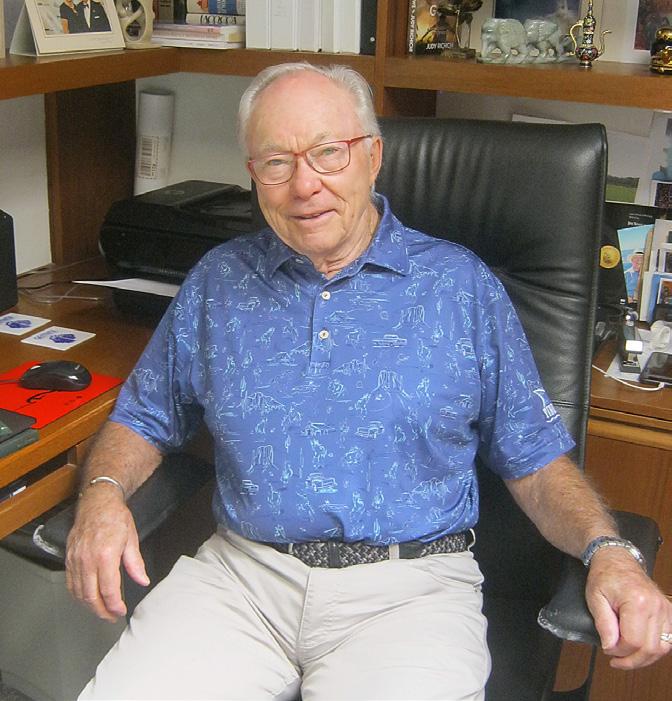
It was in 1991, after successful surgery for prostate cancer that Gary decided to take semi-retirement and spend more time with his wife, Gwen (whom he describes as “the love of my life, my soul mate, my inspiration, the centre of our family, and the cornerstone of my success in business and in my adult life”), and their then three young children.
While still working, he was honoured for his contributions to his profession through induction into the Manitoba Manufacturers Hall of Fame and the bestowing of the CME Excellence Award from the Canadian
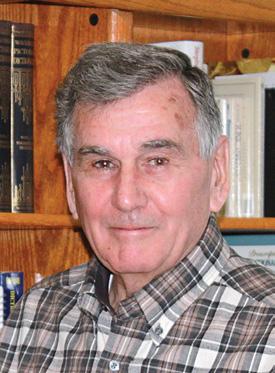
Manufacturers & Exporters. He was also named by the Council of the Institute of Chartered Accountants of Manitoba as a Fellow of the Chartered Accountants in recognition for “having rendered conspicuous service to the Institute”.
He credits his success in business to the large number of good people working with him and a diversified sales force both across Canada and around the world.
In retirement, Gary and Gwen have devoted themselves to volunteering and philanthropy. Through their family Foundation at GiftPact foundation, together with their personal contributions, they make donations annually to as many as 40 organizations with the major beneficiaries being the United Way, Siloam Mission, the Juvenile Diabetes Research Foundation, the Canadian Museum for Human Rights, the Assiniboine Park Conservancy and the HSC Foundation where Gwen is a member of the Foundation’s Bannatyne Legacy Circle and an Honorary director.
Gary and Gwen spend their winters in Florida, where he devotes his time to tennis, golf and cycling, and summers at their cottage in Lake of the Woods. They also greatly enjoy spending time with their three children, their spouses and seven grandchildren.
As Gary noted in his legacy story at the HSC Foundation, philanthropy and community service are responsibilities he takes very seriously. “You learn these things not only from your parents, but also from your close friends and business associates,” he said. “And if you are successful in business, you have an obligation to give back, not only to your community but also to those throughout the world who need assistance. In this regard, there is no shortage of opportunity to help.”
August 2023 whatsupwinnipeg.ca 5
Myron Love
Gary Steiman.
More help for seniors and housing
Dear Friends, I hope this message finds you in good health and high spirits. As the Minister of Seniors and Long-Term Care, it brings me great pleasure to share the recent developments, which have been incredibly productive for our government's commitment to enhancing the lives of our province’s seniors.
The focus of our efforts has been on ensuring that more Manitoban seniors have access to suitable and accessible housing options within their communities. To achieve this goal, the Manitoba government has allocated $15 million to advance the planning and design stages for new personal care homes. Six new personal care homes will built, with four located in the Interlake-Eastern Regional Health Authority (IERHA)
in Arborg, Lac du Bonnet, Oakbank, and Stonewall. Additionally, two facilities will be established in Winnipeg, one in the Bridgwater neighborhood and another on Portage Avenue.
and physical village models, offering progressive supports and services as Manitobans age gracefully.
Scott Johnson Minister’s Message
These strategic locations were meticulously selected to address the areas with the highest needs, and each of these projects will include approximately 670 beds collectively, although an exact number will be determined as planning and design work progresses. The initiative will be based on the innovative 'physical village model', carefully designed to incorporate social interaction, functionality, and intergenerational contact while maintaining affordability and safety. This concept aligns seamlessly with our overarching seniors strategy, promoting the development of virtual
We understand that not all seniors may require personal care homes, and as such, the Manitoba government is embarking on a pilot program known as Community Supportive Living. This program will initially be implemented in select communities and will create approximately 105 spaces in the first phase, with a total of 288 spaces overall. The pilot program will be launched in Ashern/Eriksdale and Selkirk under the IERHA, Swan River under Prairie Mountain Health, and Emerson-Franklin under Southern Health Sante Sud.
The Community Supportive Living program will operate under a threetier support system, ensuring that all clients receive personalized care and assistance. The first tier will include 24-7 onsite staff for personal care supports, while the second tier will offer 24-7 nursing supports for clients with more complex health-care needs. Furthermore, all clients will receive a
comprehensive service package that includes meals, laundry, light housekeeping, onsite therapy aides, recreational supports, and access to other health-care professionals as needed.
As Minister of Seniors and LongTerm Care, I had the privilege of attending recent events, celebrating within our senior communities. Events such as the Anavets 238 Awards Ceremony, the St. James - Assiniboia Museum annual Heritage Days, Beacon Hill Lodge's 50th Anniversary, and the Canada Day celebrations at Sturgeon Creek Retirement Residence. These events have allowed me to witness firsthand the vibrant contributions of seniors to our society. Your wisdom, experiences, and unwavering enthusiasm are what make Manitoba such a remarkable province.
Our government remains steadfast in its dedication to the betterment of your lives and the lives of future generations.
With warm regards.
Hon. Scott Johnston is the Minister of Seniors and Long-Term Care.

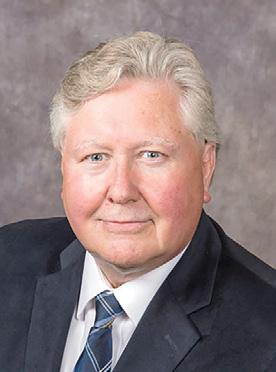
The Hon. Kevin Klein is working hard for you
With the provincial election on the horizon, I think it is critical that voters must know each candidate's priorities. I believe in being clear about my priorities, which are serving the residents of Kirkfield Park, first and foremost. Be a strong voice for our community and every resident, regardless of personal politics. After being appointed to the cabinet, which is an honour, I am still a strong voice in the legislature for our community. The cost of living has skyrocketed. Taxes are high, and inflation is still a problem, particularly for families, seniors, and people with disabilities. Many people are forced to choose between food and paying bills. That is unacceptable. Also, people are worried about crime, which
Ms Dobbie,
is fueled to a large extent by Manitoba's drug trade and chronic poverty. Access to healthcare is still a challenge for some people. Residents are also worried about climate change.
There are no fast and cheap solutions, unfortunately.
Hon. Kevin Klein
From the Legislature
My commitment is to build on the progress made by my legislature colleagues on essential files. Good ideas and people can be found across the political spectrum. The inverse is also true. I will continue building relationships with public servants across the province and country. I will bring forward new ideas and challenge policies that are bad for the residents I serve.
As the former chairman of the Winnipeg Police Board, I will continue my
years-long task of pushing back against crime. That means taking criticism from groups who want to defund police and who are content with revolving-door justice. It means delivering outcomes that make all our neighbourhoods safe.
Healthy economies are not created through rampant tax and spending practices. Underperforming economies –and hard times – are often characterized by runaway deficits and inflation. I will work with legislative colleagues and the community to help resolve the affordability crisis. As Winston Churchill once said, "I contend that for a nation to try to tax itself into prosperity is like a man standing in a bucket and trying to lift himself up."
On the healthcare file, I continue to support healthcare workers and administrators. I honour emergency responders with real action. I will continue my work with organizations like Homes for Heroes to help alleviate homelessness.
We need to celebrate our accomplish-
ments when it comes to climate policy. Manitoba is in the unique position of having the resources, experience, and wherewithal to become Canada's renewable energy powerhouse. I'm excited to keep building on this success as we work towards even greater efficiency. Our province is endowed with vast mineral resources that can help the world transition to cleaner technology. I will keep working with Indigenous communities and industry to move projects forward.
This is an important election. One that calls for steady and strong leadership from every riding in the province. I encourage voters to do their research. Does the candidate have the life and business experience to manage our province? Does the candidate have the experience to stand up for and fight for the community? However, the most important thing to do is get out and vote.
The Hon. Kevin Klein is the MLA for Kirkfield Park and Minister of Environment and Climate Change.
I’ve been reading your articles in the Lifestyles 55 newspaper for that last couple of years. Most of your articles relate to either the provincial or federal governments. Your pro Conservative and anti NDP and Liberal bias is very obvious. The two political articles in the July issue prompted me to write.

It seems that in your eyes, the Provincial government and Heather Stefanson in particular have done no wrong since coming to power in 2016. You constantly bash the Provincial NDP and Federal Liberals, and fondly reflect on the former Conservative Federal governments.
Other (unbiased) media report on the terrible health care situation in Manitoba, which is a direct result of the Provincial Conservatives cutting back on health care spending. Other media outlets have documented the dire situation with respect to healthcare in Manitoba extremely well, and I’m assuming that you are aware if you read the newspaper or subscribe to other news sources. We have friends that have waited years for hip or knee surgery. Sending patients out of province or out of country and recruiting hundreds of heath care resources from the Philippines illustrates the band aid attempt to remedy the current situation. Sending patients out of Province is extremely costly, so as tax-
payers, we’re now paying more for the healthcare, but that money is going out of province or out of country! Recent polls indicated that healthcare was at the top of the list of concerns for Manitobans.
In addition to the underfunding of healthcare, the Provincial Conservatives cut funding at the University level and even interfered with the UMFA collective bargaining process. We need more doctors and nurses trained in Manitoba that will stay in Manitoba when they graduate. With more University funding, we can educate more doctors and nurses, and provide a competitive level of higher-level education in our own province.
Your audience is the senior demographic, and healthcare is important to that demographic, so I would expect more articles that take the Conservatives to task on dropping the healthcare ball over the last 7 years.
For the record, I’m 72 years old.
Regards, Larry
Kohut
Hello, Larry.
I do not pretend to be unbiased. I repeatedly state that I am Progressive Conservative. That the WFP pretends to be unbiased is the issue. They are clearly liberal and NDP biased and anti government. I try to balance that.
I do accept articles from other parties and folks like recent NDP candidate Trudy Schroeder is a columnist. Former NDP minister Jerry Storie and the late Bill Blaikie, MP and MLA, have written for the paper. Bill had a regular column until he became ill. The former NDP senior's minister was a monthly columnist. All I ask is that any writer declare their political bias. That way the reader can decide for him or herself about what they agree or disagree with.
Regarding your comment on health care funding, you have been incorrectly informed, and the budgetary facts prove this, Funding has not been cut, it has indeed risen significantly over the past few years. But the real question is whether the problem is funding or the way the system is organized. My husband was in hospital for three months, passing away early in 2016, and I lived there with him as he slowly passed away. I observed that archaic methods were responsible for a disproportionate number of nurses doing paperwork behind the desk while two or three tried to keep up with the needs of the patients. The system rewards longevity instead of competency and this causes frustration and burnout among the workers who must deal with unfairness and bad leadership on an ongoing basis. It is time to change the way health care is operated. COVID-19 highlighted the flaws
in the system across the country where everyone is dealing with the same issues as Manitoba.
As for looking out of province for additional support, what else could be done? If people are not willing to work, you have to find workers somewhere. Would you rather let people suffer instead of getting relief from somewhere else?
The province has funded many more additional spaces for training nurses and doctors at the universities in the past year, not enough in my opinion, but it is a start. It takes time for those folks to go through the training. Just as it was the NDP who reduced the number of entrants into the nursing schools, as I was told by nurses’ aides trying to get in and having to go to Brandon for training when my husband was in the hospital. Did Pallister do all the right things? He did not. He focussed too much on cuts and not enough on development, but he did his level best. This Premier, however, has it right. She knows we cannot get all the things citizens expect unless we grow the economy. Even Wab is saying this now.
Thank you for writing to me, Larry. I will publish your letter because I do like to hear and expose other opinions. I just don't have to hold them.
Best regards,
Dorothy Dobbie
6 whatsupwinnipeg.ca August 2023
Hon.
LETTERS
Minerals, Energy and Transportation will fuel a new Manitoba economy, says Premier Heather Stefanson
Dorothy Dobbie
It is countdown time for Premier Heather Stefanson who is hurrying to get her government’s exciting agenda on the record before the blackout period preceding the fall election. People need and deserve to know where the government is heading before the heat of the campaign takes over.

Several important announcements occurred in the final week of July.
The Critical minerals initiative: removing harmful roadblocks to development
The first was the critical minerals initiative. If that sounds like gobbledygook to you, let me explain. Critical minerals are all those resources underground needed to power a modern world – minerals such as lithium, cesium, graphite, cobalt, nickel . . .there are 31 such minerals on the list and our province is home to 29 of them. EV batteries are made of graphite, aluminum, nickel, copper, steel, lithium, iron, manganese and cobalt – we have them all.
Premier Stefanson said, “We are seeing levels of investment in lithium, copper, and zinc that haven’t been seen in Manitoba for 50 years.” This is due not only to the burgeoning demand for lithium batteries to power electric cars but to a new, growth-oriented Manitoba government. The announcement on July 25 outlined the government’s strategy to support and capitalize on our resources while opening economic opportunities for all Manitobans and especially for Indigenous communities in the north. Over the past two years since Premier Stefanson took office, mineral exploration in Manitoba grew from $67 million in 2020 to $99.2 million in 2021, and $170 million in 2022, the highest level of exploration expenditures in the history of the province.
The strategy includes modernizing access to information for investors and businesses; incentives, education and training to encourage Indigenous participation; more staffing and better geoscience information and software; support for skills development; and a critical streamlining of the regulatory and permitting process, focusing on timeliness and adding electronic map staking. Value added processing and manufacturing are a key part of the plan, insuring ongoing returns to all of Manitoba.
This strategy is wrapped in an overall plan to build awareness both at home and abroad to encourage more investments and spread the word that we are indeed open for business.
The strategy document will be followed by an action before the end of the year.
A strategy for energy in Manitoba: ensuring we have the power to get us there
The second announcement was a long-awaited strategy initiative from Manitoba Hydro
“Manitoba is done being a ‘have-not’ province,” Pre-
mier Heather Stefanson said at the News Conference on July 30. The premier said, “We can’t talk about our economic growth without talking about how we’re going to power that growth. Our government is strengthening Hydro to provide clean, green electricity for our growing economy, and we will ensure it is kept affordable for all Manitobans.” She added, “Manitoba Hydro is not for sale.”
The goal of the strategy is to build on our hydroelectric advantages. Currently, Manitoba Hydro produces about 6,600 megawatts of power (Bipole 3, added only an 11% boost to Manitoba’s power resource) but anticipates needs will grow over the next two decades to 10,000 to 16,000 megawatts. How to meet that need is the challenge. Hydro Board president Edward Kenney mentioned wind power, which became the headline. However, to quote the report, the strategy is broader than that to “initiate low-risk programs or pilot projects to manage peak demand; for example: new space heating technologies: heat pumps, dual electric/ gas, storage; and to a assess new resources, storage and fuel options, market evolution and transitions in piped gaseous fuels (natural gas, hydrogen, Renewable Natural Gas).”
This multi-pronged approach makes more sense for Manitoba where severe winter climates make cheap and accessible heating fuel a necessity. Indeed, all provinces other than British Columbia see a defined, limited role for natural gas, which is relatively clean in terms of CO2 emissions. Right now, Manitoba has one of the lowest emitting electricity systems in the world, equal to about 17 hours of CO2 output in China and less than one-third of the neighbouring province of Saskatchewan. And that includes our use of natural gas for heating.
The report also sees a “role for independent power producers to provide new energy supply to the grid.” Power generated by these technologies would be sold for redistribution by Manitoba hydro. The plan also envisions newer meters to allow for lower pricing for consumers in off hours.
u Culinary Memories
Continued from page 1
herb for each time of the year.
Cooking is not Ian’s only talent. He has also illustrated every one of his recipes with his own beautiful photographs taken from his freshly prepared master pieces. The illustrations are stunning, and as Ian would say, they are guaranteed to make your mouth water.
As for the recipes, there is everything from main courses to appetizers and desserts. My favourite, and I have been the lucky guest at many of Ian’s five course dinner parties, is Cod and Peas. I don’t know what he does to it, but the dish is a taste of heaven. It has that undefinable “umami” taste that Ian loves to achieve in his recipes.

Why did he leave cooking? Well, as he
tells it, getting up at four in the morning to begin the day doesn’t exactly suit a young man’s lifestyle. And at Pegasus, we are glad this happened because it means he could turn his many talents toward making Pegasus a better company. We celebrate his 20th year with us this month.
Thank you, Ian.
P.S. For any of you readers who remember the lovely garden parties we had when I chaired the WSO, Ian was the man behind the fabulous desserts that were always the final course of the event. Buy his book and learn how he did it! To reserve your copy at a special low price of $25.00 please call Erica at 1-888-6802008.
A new rail line and port for Hudson Bay

Not formally announced but part of an MOU with Alberta and Saskatchewan signed some months ago with our transportation minister, Doyle Piwniuk, is the most exciting development and has the most potential for Manitoba and for Canada. This is the plan to build a railway line feeding off the Northern Gateway (Churchill) line from Amery, just past Gillam, to Port Nelson on Hudson Bay. This line offers the ground stability to handle heavy loads at a commercial speed and the port will be better able to accommodate the larger ships of today than can the Port of Churchill. It will be in operation year-round and be able to handle transport of heavy metals, potash, manufactured products, and LNG. This provides access from the west and even the south as well as east from the Ontario Ring of Fire.
The line, called NeeStaNan, will be owned the local Indigenous communities in partnership with the provinces of Manitoba, Saskatchewan, and Alberta.
“NeeStaNan will be a game changer for the entire country,” said Premier Stefanson. “Manitoba stands to benefit from billions of dollars’ worth of trade, while local indigenous owners and communities will be able to build a robust economy around the line and the new port. Transport to Europe from Hudson Bay is a whole day closer than from traditional ports but it also gives us better access to South American countries such as Brazil, one of the fastest growing populations and economies in the world.”
She went on to point our how this would open the isolated north eastern part of the province for better access by local communities such as Shamattawa.
“The Churchill line will also benefit,” she pointed out, “because they will be the link to the Saskatchewan part of the line and NeeStaNan will increase their traffic.”
A consortium of local and out-of-province Indigenous leaders, along with several industry leaders from all three provinces and some local advisory group members have been working on this plan for the past five years. It rounds out the recipe for growth that the Premier has been envisioning, all of which promises an exciting and reinvigorated Manitoba for the next four years.

August 2023 whatsupwinnipeg.ca 7
Heather Stefanson
The Premier’s priorities
The original Hudson Bay Route Plan of the Nelson Estuary (1927). Created by F. Palmer. Image Courtesy of University of Manitoba: Archives & Special Collections
The famous Cod and Peas.
Farewell message
After almost 25 years in public office, I have made the decision not to seek re-election in the 2023 provincial election. The time has come for new adventures. It has been a great honour and privilege to have served my constituents of Charleswood and now Headingley as MLA since 1998.
I appreciate the confidence that was placed in me when asked to serve in a number of positions over the years: Legislative Assistant to the Ministers of Health and Families, Health, Finance & Education Critic, Interim Leader of the PC Party of Manitoba, and Deputy Leader to name a few.
Women Parliamentarians (CWP) as well as the Commonwealth Parliamentary Association (CPA). It culminated in my being asked to take on the role of CWP International President in 2022.
One of my most fulfilling achievements in Charleswood is the development of the Charleswood 55+ Active Living Centre following my initiative to bring seniors together to celebrate the International Year of Older Persons. The other is the Community Leaders Networking Luncheons where community leaders come together twice a year to network, connect, and form community partnerships that benefit our community.
Myrna Driedger Broadway Journal
I am grateful to have had 5 Private Member’s Bills passed during my career. Most notably those that helped to prevent sexual assaults caused by date rape drugs and increase awareness, and to establish the Nellie McClung Foundation. The latter led to the monument of Nellie McClung and the Famous Five on the grounds of the Manitoba Legislature.

Recognizing Nellie McClung wasn’t just about the past. It was also about inspiring girls and women to know that they, too, could be leaders and create positive change. For every little girl who can see a woman making a difference in the lives of others is one more little girl who may be inspired to follow suit.
My advocacy over many years to have a women’s heart health program became a reality after the 2016 election. As a former neuroscience nurse, I was determined to do everything I could to have a gold- standard stroke unit in Manitoba, and I am most grateful to see this about to become a reality.
While it was never my intention to pursue the position of Speaker of the Legislative Assembly, I can say that being elected twice by my colleagues to serve as Speaker has been a demanding but rewarding experience. I am honoured to have been able to work with our legislative team to enhance our programs and services, modernize the workings of the Legislative Assembly, and implement a leadership development program which resulted in the first Mission, Values, and Aims Statements for the Assembly.
As Speaker, I have experienced many unique opportunities. I led our Assembly through the COVID-19 Pandemic. I created and curated the content of a time capsule in celebration of the 100th birthday of the Manitoba Legislative Building, oversaw the historic Manitoba Legislative Chamber renovation to improve accessibility, initiated a Women Trailblazers of the First 100 years permanent exhibit at the Legislature, as well as a Vote100 permanent exhibit to recognize Manitoba women being the first in Canada to be granted the vote. I am also pleased to co-chair the Manitoba Legislative Building Restoration and Preservation Advisory Committee.
As a strong advocate for women in leadership, I was pleased to see Manitoba welcome their first female premier. Over the years I became very aware of the challenges women face to get into politics and other leadership roles. This led to my deep commitment to address this deficit through my provincial, national, and international roles with the Commonwealth
I want to thank the residents of Charleswood and Headingley for entrusting me as their representative through 7 elections. I also want to thank my wonderful Constituency Assistants, Constituency Association, and all my supporters throughout my years in politics for their commitment to me and for their tireless efforts to support me. I offer my sincere appreciation and want them to know I will forever be grateful and humbled.
Thank you to my family, friends, constituents and the many volunteers, past and present, for the incredible trust and support you have given me over the years.
I would also like to acknowledge the many members of the PC Caucus whom I have had the privilege to work with and enjoy friendships for over 25 years. I am truly thankful for my journey in public life and look forward to what the next chapter will bring. I also look forward to more time with my family, especially my 2 young granddaughters.
And a final comment: it is healthy for democracy if MLAs respectfully express different opinion. It is not healthy for democracy if we can’t do it with decency and respect. Democracy right now is so fragile. Now, more than ever, we need us, as lawmakers, to transcend partisanship and learn how to work together. According to a neighbour of mine, as a society we have lost any ability to judge policy based on merit. We attack it based on whether it comes from the left or from the right. The rising toxicity in politics and perpetual anger erodes the foundation of democracy. We must do better.
I am genuinely thankful for my journey in public life, and I look forward to what the next chapter will bring. Public service has been an honour and a privilege.
Hon. Myrna Driedger is MLA for Charleswood and Speaker of the legislative assembly.
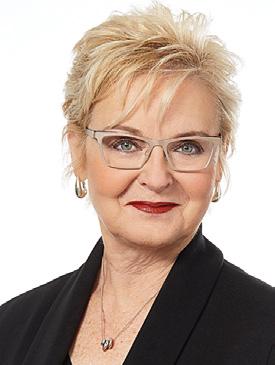
Centreport Canada Rail Park welcomes Fastfrate Group as it's first tenant
Fastfrate Group, one of Canada’s largest privately held transportation and supply chain providers, is investing $55 million to build approximately 140,000 square feet of facilities in the CentrePort Canada Rail Park (“Rail Park”). Situated on 25 acres in the Rural Municipality of Rosser, Fastfrate Group is the first tenant to break ground in the 665-acre industrial rail park project, in development by Focus Equities Inc.
“It’s so exciting to be breaking ground today on what is an extremely important economic project for Manitoba,” said Premier Heather Stefanson. “This is just the beginning of creating more good jobs with this economic corridor. I’d like to congratulate CentrePort on this milestone, and I thank Fastfrate Group for choosing Manitoba.”
Having outgrown their existing space on Keewatin Street, the new facility, expected to be operational in the fall of 2024, will enable Fastfrate Group to rapidly expand their existing operations in Manitoba, bring new service offerings to the local market, and create upwards of 150 new jobs within the first 12 months of operation.
“Fastfrate has been in business for 57 years, and we have serviced Winnipeg for over 50 years. During that time we have become part of the fabric of the city, and we are very proud to further serve the community,” said Ron Tepper, Executive Chairman, Fastfrate Group.
This groundbreaking project will mark
the first occasion where Fastfrate Group of companies will be strategically co-located and jointly operated from a single shared site. This model is set to become a blueprint for expansion into other markets across Canada. This will allow them to optimize efficiencies to enhance their ability to provide a full suite of services to their valued clients.
“Fastfrate Group’s choice of location within the Rail Park allows us to have access to road and rail infrastructure, proximity to the Canada-US border which will position us to expedite shipments seamlessly across borders and pursue new opportunities in collaboration with CPKC,” said Manny Calandrino, CEO of Fastfrate Group.
Fastfrate, the LTL division of Fastfrate Group, is one of Canada’s largest privately held intermodal LTL carriers and will set new heights in Manitoba with their CPKC partnership by growing opportunities that extend beyond borders. The strategic location of the new facility opens doors down south to the U.S. and into Mexico.
Among the Fastfrate Group of companies included in this project is Challenger Motor Freight (“Challenger”), one of North America’s largest cross-border truckload carriers and logistics providers which will be making its debut in the Manitoba market as part of this strategic move. Challenger transports goods across North America as well as internationally with a full range of transportation, logistics, and managed supply chain services.
Challenger currently manages 500-700 border crossings a day nationally and plans to grow their Manitoba cross-border business from the new site in the Rail Park.
To provide the full menu of services, ASL Distribution and Canada Drayage Inc, also part of Fastfrate Group of companies will operate from this facility bringing the full scope of supply chain solutions under one roof.

ASL Distribution: Seamless, customized transportation, warehousing and distribution services including e-commerce order fulfillment and final mile deliveries direct to consumers.
Canada Drayage Inc.: The only national drayage company in Canada, manages the transport of sea containers to and from major ports, rail yards and distribution centres across the country and into the U.S.
“Fastfrate Group is the first tenant announced in the CentrePort Canada Rail Park project and we are thrilled to welcome them to the RM of Rosser,” said Ken Mulligan, Reeve, RM of Rosser. “Fastfrate has set the standard for the calibre of companies that are choosing the Rail Park as their home and we look forward to more exciting tenant announcements to come.”
“Today, our vision for the CentrePort Canada Rail Park as a transformational project for Manitoba is coming to fruition and we look forward to seeing its long-term impact on the community and the companies who locate here,” said Ken Mariash, Owner, Focus Equities Inc. “We
have worked hard over the last five years to create a rail-served industrial development in order for globally connected companies to thrive in the heart of the continent. Our goal to attract new businesses to Manitoba is being realized with industry leaders like Challenger choosing to establish a presence in the market and Fastfrate Group making a commitment to grow their business in Manitoba.”
“CPKC congratulates the entire Fastfrate Group team on the groundbreaking of their new facility at CentrePort Canada Rail Park,” said Jonathan Wahba, CPKC Senior Vice President, Sales and Marketing, Bulk and Intermodal. “FastFrate has been a CPKC customer for more than 50 years and we look forward to helping Fastfrate grow its intermodal business across the continent, utilizing CPKC’s unrivaled network connecting their customers to markets in Canada, the United States, and Mexico.”
“This is the first company to announce their plans to locate in the Rail Park, so it marks an important day in CentrePort’s history,” said Carly Edmundson, President and CEO, CentrePort Canada Inc. “We thank Fastfrate Group for their investment, which brings jobs and opportunities to Manitoba, and we wish them much success as they leverage the inland port’s many strategic advantages to grow their business.”
For more information on CentrePort Canada Rail Park, visit: https://centreportcanada.ca/developmentadvantages/#rail-park
8 whatsupwinnipeg.ca August 2023
Nellie McClung and the Famous Five monument on the grounds of the Legislative Grounds. Photo by Garry Stewart.
$55 Million project brings transportation leader Challenger Motor Freight to Manitoba
Community champions are our heroes – all the things you do make a big difference –#GiveBetterFutures
At Children’s Hospital Foundation of Manitoba, we know our community is stronger when we work together.
Community champions who sell lemonade, host golf tournaments, and find other ways to get creative in support of sick and injured kids make a massive difference every single year. In 2022-23, this dedicated group rallied to raise over $1 million to #GiveBetterFutures!

How incredible! Over $1 million when we add up all the proceeds from bake sales, tournaments, BBQs, and more. When I meet these devoted supporters, I am so deeply inspired by their creativity, tenacity and passion.
Our community champions include organizations like GymKyds Gymnastics Centre, where in 2022 the gym team hosted a fundraising event with bear gymnastics, face painting, crafts and more. With over 1,000 kids visiting, this amazing crew raised almost $3,100. And this year they did it again, bringing in a record $7,000 for families in hospital – wow!
There are countless more, like the Pryor Family who put together a superhero-themed social in Crystal City, MB to honour Kellan Pryor, who was
born with a rare bone marrow disorder and passed away at four years old after spending much of his life at HSC Children’s.
There are amazing events that happen year after year, like the employee-led BMO Bear’s Paw Golf Tournament that’s in its 32nd year and has raised over $1.5 million since its inception.
And local businesses engage their customers to support families in hospital, like the Popeyes Chicken where a Sandwich Combo promo raised more than $10,000 for specialized tools in the Pediatric Epilepsy Monitoring Unit at HSC Children’s.
We also have so many #KidsHelpingKids, like Alexis, who made and sold Christmas ornaments; Georgia and her mom, Jenaya, who had a fall pumpkin stand; and the students in Ms. Bacon’s Grade 1/2 class who were awarded funds through a Winnipeg Police Association Cool 2Be Kind grant to purchase books for the HSC Children's Library Program. These young donors all find their own unique ways to make an impact, and we’re so grateful.
And we can’t forget about the longest-running community event in sup-

port of sick and injured kids in Manitoba – the Children’s Hospital Book Market, which started in 1961. After a two-year hiatus due to the pandemic, Book Market returned to St. Vital Centre in the fall of 2022 with 87 pallets of books, delighting readers and raising over $246,000. Please save the date for the next sale September 15 – 16, 2023. We truly are so much stronger when we work together, and every dollar counts for sick and injured kids and their families. Every craft sale, event, and fundraising promo helps fund life-saving equipment, leading-edge re-
search at Children’s Hospital Research Institute of Manitoba, and comfort programs like music therapy.
On behalf of the board and all the staff at Children’s Hospital Foundation, I want to say a huge thank you to all the community champions who work together to #GiveBetterFutures!
If you would like to start your own initiative to #GiveBetterFutures please visit goodbear.ca/CommunityChampion.
Stefano Grande is the president and CEO of Children’s Hospital Foundation of Manitoba.

Challenge to provincial candidates: Time to tear down the Arlington Bridge before it falls down! Where do YOU stand?
To celebrate the 100th Anniversary of St. James (starting just west of St. James Street to Sturgeon Road) breaking away from Assiniboia to form their own municipality, I am doing street profiles.
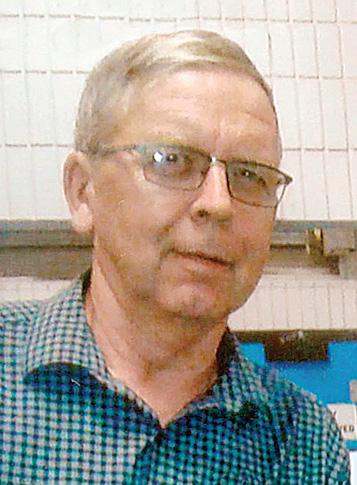
Long-time North End Winnipeg
Alderman John Blumberg made the following two comments about the Arlington Street Bridge on Page 3 of the July 30, 1946, Winnipeg Free Press: “The sooner the bridge comes down and a modern one goes up, the sooner the city will maintain expenses.” Sub head, “Alarming” Blumberg's reaction to recent bridge inspections.
Why has this problem not been resolved in the past 75 years?
During the early 1900s, Arlington Street turned into Brant Street at Notre Dame. On February 5, 1912, the Arlington Bridge was opened connecting Brown Street in the north end with Brant Street. Brown and Brant were renamed Arlington.
Arlington Street now ran from the Assiniboine River into the North End. There have been attempts to connect the Arlington Bridge to south Winnipeg. On July 3, 1912, a newspaper notice announced that a bridge would be built connecting Arlington Street and Mitchell Street in the south. In 1957, a Greater Winnipeg Traffic Report recommended building a bridge connecting Aubrey Street (just west of Arlington) to Waverley Street. Neither idea happened. We should accept the fact that traffic coming off the Arlington Street Bridge will have to divert 7 streets over to Maryland to ac-
cess South Winnipeg.
The steep inclines on the new Arlington Bridge created immediate problems. Safety concerns resulted in the cancellation of the planned streetcar service over the bridge before the first streetcar had travelled over the bridge.
The bridge was repaired in 1931, 1943, 1946, 1947, and 1952. These repairs included deck, sidewalk, and foundation repairs. Some of the problems were caused by smoke from the locomotives. On July 20, 1965, a front-page Winnipeg Free Press Story reported that the bridge was badly rusted. Weight restrictions were implemented to extend the bridge's life by five years. Fifteen years later, in 1979/80, city Council approved the Sherbrook McGregor Overpass to replace the Arlington Street Bridge.
The direct link from McGregor, a key North End street to the Health Sciences Centre and Maryland Bridge, is actually a better north-south corridor than Arlington. The Progressive Conservative provincial government of Sterling Lyon committed funds. However, the City Council changed its mind due to strong community opposition.
In 1992, Arlington Bridge was closed for a 6-month repair. The repair was expected to add 10 or 20 years to the life of the bridge. In 2000, the bridge was closed twice when train accidents damaged the bridge’s girders holding up the approaches.
In 2007, a comprehensive Winnipeg Free Press report graded most Winnipeg bridges. Arlington Street was rated POOR. In 2018, Global News expressed
concerns about severe corrosion and cracks. (1) On April 19, 2019, the Bridge was temporarily closed due to asphalt problems. In 2020, the Bridge was closed for several weeks. These repairs included asphalting the entire bridge.
The possible relocation of the CP Rail yards has long been used as an excuse not to build a replacement bridge. There is always a slight chance that the rail yard relocation may eliminate the need for existing bridges. However, this argument has not stopped the construction of other bridges or underpasses over or under rail lines. Salter Street bridges have been built in 1898, 1932, and 1984. A CN line running thorough East and South Winnipeg created traffic problems. These problems have been eased by the construction of underpasses at Kenaston, Plessis, and Waverley.
The city has kept the bridge open through frequent inspections and closures. However, we cannot inspect any bridge every day. The severe rust could cause problems at a moment's notice. An administration report to city Council on June 20, 2019, clearly states that the Bridge may have to temporarily or permanently close with no notice.
After 75 years of warnings, the time
has come to tear down the Arlington Street Bridge.
On February 10, 2023, CTV reported that the city was conducting a $850,000 Feasibility Study to extend the life of the bridge by another 25 years. How can any of the 13 members of the current city Council who voted to adopt the 2019 Report saying the Bridge was almost beyond repair now authorize spending city tax dollars to contradict their 2019 position.
The real question is whether the Arlington Street Bridge is still safe. All three major Manitoba political parties seem to have an identical position on this issue. “It is a city issue.”

However, there have simply been too many red flags over the past 75 years. The province should step in and inspect the bridge. Future regular inspections should be done by both the city and the province.
Let us hear from provincial politicians during the election campaign on this issue.
Notes:
August 2023 whatsupwinnipeg.ca 9
Fundraising lemonade stand.
1. Article by Elisha Dacey quoting Young Jin Cha a Civil Engineering Prof. Fred Morris is a Grandfather, Sports Fan and Political Activist.
Fred Morris From the desk of a gadfly
The iconic Arlington Street Bridge.
Stefano Grande Healthy Living
u Kathleen Richardson, inducted into Citizens Hall of Fame
Continued from page 1
RWB’s Arnold Spohr would be ecstatic to know that he and Kathleen both occupy a spot in the Winnipeg Citizens Hall of Fame.
As one of the initial students to take classes through the Winnipeg Ballet Club, the school that would later become the RWB, Kathleen developed a deep love and appreciation for dance and the ballet. Although she ultimately chose a different career path, Kathleen’s unwavering commitment to the organization remained. She, and her mother Muriel Richardson before her, saw the potential of a world-class ballet company in Winnipeg and realized what it could bring to the profile and prestige of the city. Kathleen went on to serve as President of the RWB board of directors, from 1957 to 1961, after which she became honourary President until her passing.
Kathleen was more than a savvy businesswoman and lover of the arts. She was also a community leader and volunteer, one who championed many of Winnipeg’s cultural endeavours. In the 1970s, she was often seen selling tickets to fundraising events in the public area of the convention centre. Though she could have bought all the tickets herself, Kathleen sat at the table along with other volunteers instead and encouraged passersby to support the arts and the RWB in particular.
Among her many achievements with us, Kathleen was instrumental in securing a permanent home for the Royal Winnipeg Ballet. In 1986, she chaired the RWB’s Capital Campaign, which raised $5.5 million in private

contributions for the $10.3 million project, that resulted in our magnificent building opening its doors in 1988.
In fact, during her most active time with the RWB, the organization experienced incredible growth and we reached new heights of international recognition and acclaim.
Kathleen was humble, quiet, and unassuming in her numerous contributions to the arts. Everyone she met was captivated by her charm, wit, and grace, including our own Evelyn Hart, who had a special connection with Kathleen. She and I also developed a close relationship. I still miss our dinners every three months for 20 years, where I would bring her up to
speed on the RWB and listen to her welcomed and wise advice.
Always preferring to remain anonymous, Kathleen’s extraordinary generosity enhanced the work of organizations and communities, and positively impacted countless Canadians. She strongly believed in the words quoted by her mother: “Unto whom much is given, much is also required” and she lived these words!
When Kathleen was promoted within the Order of Canada to Companion in 1993, her citation read in part: “A pillar of support for the Royal Winnipeg Ballet, she has given unstintingly of her resources over the years to ensure the continuing high stature of the company.” As such, nominating Kath-
leen Richardson for the Citizens Hall of Fame distinction was no decision at all. It was nothing less than a fait accompli for this remarkable humanitarian and RWB friend.
My colleagues and I extend our deepest gratitude and appreciation to Kathlee. There is no telling where the Royal Winnipeg Ballet would be today without her abiding love, guiding light and steadfast backing. The RWB honours her leadership and legacy, her indelible footprint on the organization. As we continue to raise the barre at Canada’s Royal Winnipeg Ballet, “our pillar of support” remains in our hearts, as does her incredible investment in the art of dance in the city of Winnipeg!
Remember concert features music of hitmakers the Carpenters and Mamas and Papas



music Douglas loved growing up.
As the summer winds down, why not attend a concert featuring the music of the 60s and 70s hitmakers the Carpenters and the Mamas and the Papas? Local singer Nadia Douglas and her band plus local folk rock band the Very Groovy Things will bring back memories with music that ruled the airwaves during that fertile era in pop music history.
The concert will be held on Thursday, August 31 at 7 p.m. at the Salle Pauline Boutal Theatre at the Franco Manitoban Centre, 340 Provencher Blvd. Tickets are available for $30, all taxes included at Eventbrite.ca. Just search “Remember” and you can purchase your online tickets in advance.
Nadia Douglas is a mainstay of the local jazz scene in Winnipeg. She has appeared with the Winnipeg Jazz Orchestra, at the Winnipeg Jazz Festival,and the new Club Room at the Hotel Fort Garry, to name a just a few recent performances. She has always included a few Carpenters songs in her show, but decided, along with her pianist and music director Rick Boughton, to dedicate a set to the 70s
“I’ve had such a great response to the Carpenters tunes in my shows that I thought more of the catalogue was worth exploring. Then Bill Quinn from the Groovies approached me about doing a show together with that bans, and it was a no-brainer.” says Douglas.
The Very Groovy Things Band was formed in 2018 with some of Winnipeg’s finest singers and players. The singers include Quinn, tenor Dan Rochegood, soprano Olivia Maxfield and alto Jodie Borle. Borle had already developed a following as one of the city’s best jazz vocalists, but loved the idea of singing in a band doing 60s music. Quinn and original guitar player Laurie MacKenzie figured a band doing the music of the Mamas and Papas could capitalize on the trend of many groups covering classic rock acts playing in Winnipeg. The 10 piece folk rock band started small, playing house concerts and some special events.
The group saw the potential for bigger venues when they sold out the Berney Theatre in March as part of the Music and Mavens series at the Rady Jewish Cultural Centre. Quinn figured a Carpenters/Mamas and Papas show would be something a baby boomer audience would enjoy. Hope to see you there!
10 whatsupwinnipeg.ca August 2023
James Richardson, Joan Richardson, Dan Hursh, Sprague Richardson, Madeline Vrignon, Katie Hursh, Hartley Richardson, LVO, O.C., O.M., LL.D., Heather Richardson, Natalie Richardson, André Lewis. O.M., and Jim Richardson.
Bill Quinn
Photo of The Mamas and the Papas performing on The Ed Sullivan Show. From left: Michelle Phillips, Cass Elliot, Denny Doherty, and John Phillips. Photo courtesy of CBS TV.
‘Le Boeuf’ is always a treat no matter what time of year

There is something to be said about a roasted prime rib joint of beef. It’s like music to my ears when I hear that sizzle as it appears out of the oven. The aroma follows and my palate salivates.

I know the price of beef is through the roof, but with visitors coming over it had to be done. A treat even when expensive is always be welcomed.
There are so many ways to cook beef. We all have our own special way, but this one is easy and not time consuming. What I get from this dish is that umami experience when it is almost done. The way the aroma tantalizes my appetite drives me crazy.
Here is what you will need.
Seasoning mixture
1 tsp. lemon pepper seasoning
1 tsp. cayenne pepper
1 tsp. black pepper
3 tsp. paprika
2 tsp. crushed sea salt
1 tsp. finely chopped fresh thyme.
1 tsp. finely chopped fresh sage.
2 tbsp. Dijon mustard
2 tsp. freshly crushed garlic clove
Other bits to make it complete.
2 carrots roughly chopped.
1 large onion roughly chopped.
2 sticks celery roughly chopped.
1 four rib joint of beef
1 litre beef stock
The all important how to
Preheat oven to 325° F. In a small bowl add all ingredients for the seasoning mixture. Blend together to form a paste like substance.
Place thee roughly chopped carrots, onion, and celery in the bottom of a large roasting tine. The place roast on top, fat side up; rub with seasoned mixture all over.
Ian Leatt Foodies
Roast 2 ¼ to 2 ¾ hours or until meat reaches desired temperature (for medium-rare, 135°; medium, 140°; medium-well, 145°). Remove roast from oven and place on to a serving platter. Tent with foil. Let stand for a minimum of 20 minutes before carving.
Meanwhile, using a large sieve, pour all the drippings, vegetables and loosened browned bits from the roasting pan into a medium saucepan. Skim all fat off the liquid. Add the 1 litre of beef stock to drippings; bring to a boil. The liquid may be a little thin. To thicken simply add a little corn starch to cold water and mix in until you achieve the desired consistency.
As we are in the summer, fresh new potatoes and veggies from the garden make for a well-rounded meal. Enjoy.
Ian Leatt is general manager of Pegasus Publications and a trained chef.

All about woodpeckers
One of the most popular and enjoyable birds to attract to the backyard are woodpeckers. These active birds are colourful and entertaining with most species being year-round visitors. They are part of the family Picidae and are found throughout the world excluding a few locales such as New Zealand, Madagascar, and New Guinea. There are over 250 species in this family with less than 20 of them found in Canada which also includes sapsuckers and flickers. The majority of woodpeckers dwell in mature forests and suburban areas and while others are found in desert areas where cacti are their preferred habitat. They can be seen clinging to trees as they search for insects and rarely perch but flickers spend most of their time on the ground.
Woodpeckers range in size from as small as 8 cm in length up to 60 cm for the largest woodpecker in Canada, the amazing Pileated woodpecker. The colors of most woodpeckers are typically black, white, and red although the flickers are brown and some also have yellow in their feathers. Most species have notable patterns to their plumage like barring, speckling, or banded. Of course their most notable trait is the long pointed bill, designed to chisel into the wood of dead trees. Their nostrils are covered by bristle like hairs that protect them from debris as they hammer into the wood. They have unusual feet compared to other birds, 2 toes in the front and 2 in the back although some have 3 toes in the front like the appropriately named, Three-toed woodpecker. This design is to cater to their need to cling to trees.
They also have strong tail feathers to help them maintain their balance and to help them propel through the trees.
The diet of woodpeckers is mainly insects and their larvae. If you ever see a woodpecker ‘damaging’ a tree, sadly the damage is already done internally by insects. Woodpeckers have no interest in burrowing into healthy trees. Their purpose is to find the wood-boring insects that damage or even kill our trees. Many trees may appear healthy but once the woodpeckers start their work, it is evident the damage that the insects have already done. They will also eat berries and seeds.
After excavating a cavity in a dead tree, woodpeckers will lay 2-8 eggs during nesting season. No actual nest is constructed and just the wood chips are used as bedding. The young are cared for by both parents and it is a common sight to see the whole family at birdfeeders once the young have fledged.
Woodpeckers contribute to humans more than we may realize. Their consumption of nuisance insects is significant. Bark beetles cause extensive damage to trees and infestations can be catastrophic to large areas with the population of these beetles in the billions. When this happens, woodpeckers are observed in significant numbers in these areas eating the larvae which aids greatly in reducing the beetles numbers. Orchards are often plagued with Codling moths and Hairy woodpeckers are recognized for controlling these outbreaks.
Concussions and other brain injuries are all to common in sports. Woodpeckers have contributed to the science in helping prevent these injuries.
When woodpeckers drum on trees, it is recorded at 20 times per second and some may drum 8000-12,000 times a day! The thought of that would give us humans a real headache but why not the woodpeckers? It does get pretty scientific but the basic protection factors include flexible skulls, a special bone called a hyoid bone that surrounds the inside of the skull to protect the brain, and even their beak is designed to absorb some of the impact. This information has been, and continues to be used in designing helmets and other protective gear in sports.
At birdfeeders, woodpeckers can be attracted all year long by offering suet,

nuts, and seed cakes. There are suitable types for each season to make them daily visitors. Look for suet that has more nuts than seeds and there are special feeders designed for shelled peanuts to cater to woodpeckers. Seed cakes are compressed blocks of seeds or nuts held together with gelatin and come in various shapes with accompanying feeders, select the more nutty versions and some even have insects which are a great choice! Attracting these entertaining birds is easy and they also help us gardeners out by eating all the nuisance insects we can’t reach!
Sherrie Versluis is an avid birder and owns The Preferred Perch on St. Mary’s Road in St. Vital. Phone: 204-257-3724.

August 2023 whatsupwinnipeg.ca 11
Sherrie Versluis Feathered Friends
Advice to Geocachers: Time now!
Half past summer
With the start of August it is a good time to concentrate on non-winter friendly Geocaches. In a few months those will likely be buried under that white stuff that has a habit of showing up every fall.
My wife and I always seem to wait too long for some of them and the expression, “Oh well, we’ll get them in the spring!” has become too common. We have been working on them this summer and are planning to continue to shorten that particular list.
How do you know which ones are not winter friendly? If you are not a premium member you are pretty much limited to searching each cache page individually to look for the snowflake with the red circle and line through it in the attributes. (Much like the red circle and line on a no smoking or no parking sign.) You should also check the description for the words “not Winter Friendly (or similar)” as some Cache Owners either don’t use the attributes choosing instead to write it into the description or just don’t use them at all.
The news is somewhat better for premium members. You can use Pocket Queries to search for not winter friendly caches. Alternatively you can do a search for those caches you have not found, take a screen shot
and then search for winter friendly ones. Use the last search to eliminate the friendly ones from your screenshot.
Now, what is a not winter friendly cache? The short answer is a generalization. Above the knees is used by many to try to figure out a winter friendly cache so below the knees is a good benchmark for a not winter friendly cache. Some not winter friendly ones may be above this though, depending on the location and how the weather affects it. The cache owner is expected to use their best judgement to determine this.
Some examples of not winter friendly caches are Tupperware or Loc N Loc containers hidden in hollows at the bottom of a tree, under a fallen tree, under a structure (building, bridge, etc), a hollow log, or anywhere else that one of these containers may fit. Many times they will be covered with natural camo. That could be branches, leaves or anything that is natural to the area it is in. Pill bottles will be something that you will run across hidden lower. They may be covered in camouflaged tape or painted to match the location they are in. Ammo boxes are a container that is not as common as they used to be. These are commonly in a spot where you need to do some bush crashing.
Economic soft landing?
Crypto is going to change the world, they say. AI is going to change the world, too. None of that matters though, because the world won’t even be habitable by 2030 if the UN IPCC is correct. They call it “Global Boiling” now. Also consider that we are collectively experiencing massive ideological culture wars, woke-corporate boycotts, and that anyone who disagrees with Wall Street’s post-modernist view is a racist and a bigot, so we are told.
Despite all this fearmongering, noise, and craziness, many corporations are posting big earnings on Wall Street, beating expectations by a country mile and leading many bank economists to forecast a “soft landing” for the economy. What does a soft landing mean, anyway? Well, a soft landing means the economy still grows and does not contract as it would in a recession, albeit the growth is minimal. Think back to the Obama years where, after 2008 financial crisis, the economy
recorded a tepid 1.6% average annualized growth rate. Dare I say it, this time it’s different.
The first big difference is that interest rates are the highest in 20 years and climbing and this is finally having an impact. The middle class is scrounging for change to afford the necessities of life. Consumers are choosier than ever, also, and delaying major ticket items. Airline passenger traffic is showing signs of slowing, air freight is down, new and used car prices are lower, consumer spending is still increasing but just barely, and housing, well… housing is still a major problem.
The second difference is that back in 2008 analysts were actually recommending that the US burn down empty or condemned homes to create more demand. But today there is not enough housing supply, and demand is being driven even higher partly due to wide open borders and a flood of immigrants and asylum seekers. However, more and more homes are not for sale because sellers know they won’t get the same mortgage rates they currently have for their next home. Buyers are holding out because prices are still near record highs. Housing prices must come down. Also, in a bizarre twist commercial properties are empty and can’t be filled because of work at home policies. Major skyscrapers are being handed to the banks that financed their purchase or construction, because their owners know they have lost profitability. What is terrifying is that commercial property owners are willing to walk away from assets worth hundred of millions instead of taking losses to their income, maybe because they can foresee what is to come.

The third is that the state of information in the world is not uniform, people are more polarized than ever and the culture wars have taken a big bite out of companies adopting DEI/ESG policies. Take a look at what’s happening to Bud
Fake rocks, usually designed for holding your spare house keys as well as real rocks drilled to hold a log book are something that can be a real nightmare. Imagine for a moment someone taking one of the rocks at the edge of a bridge home, drilling a geo hole in it and returning it to the location amongst the three or four hundred other rocks that resemble it. Hopefully they set the difficulty level to something that warns you of it.
I have seen sprinkler heads in the middle of an area, small centrifugal tubes glued to a piece of wood in a spot with other wood chips (tube inserted into the ground), a piece of wood hollowed out just lying on the ground and small zip lock bags covered in duct tape or camo tape sitting under some leaves, all holding a geocache log.
With 3D printers becoming more common there are a lot of new designs showing up. They have made it easy to have geocaches be anything you can imagine.
All of these are next to impossible to find after the snow falls, but some people really enjoy the challenge of finding them. Both my wife and I will leave them for an easier time, as long as we remember to. Oh well, we’ll get them next spring.
We would love to meet you on the trail.
Gary Brown is the President of the Manitoba Geocaching Association (MBGA) and can be reached at MBGAexec@outlook.com.

Light, Target, or Disney. Sales are down double digits in some cases, entire departments and distribution networks are gone, not because the product changed, but because consumer sentiments toward the brand did. This is happening on a massive scale for many companies who thought to do the right thing in a post-George Floyd world, but who are simply alienating their customers. The culture wars are adding significant weight to already very wonky markets as corporations needlessly shoot themselves in the foot.
The next major difference is that climate alarmism is at an all time high. Despite the fact that not a single longterm climate related prediction made by any major governmental body has come true, we are beholden to a trampling of news media telling us the world is on fire and that the rich people in the West are to blame. No one seems to be talking about the billion plus impoverished people out there who are burning wood and dung for energy (one of the most pollutant and significant contributors to CO2 emissions) or that China and India are building numerous new coal power plants. Imagine the decline in CO2 and pollution that investing in LNG exports would have brought to that part of the world, but we didn’t. Instead, governments of the West are hell bent on spending whatever it takes to support bank syndicated investments into massively industrial solar and wind power, regardless of their low and unreliable power output and high cost versus going with cheap and safe nuclear power and planting a billion trees that literally suck the CO2 from the air and put it in the ground. The fiscal irresponsibility, cronyism, and environmentally harmful infrastructure built around the “green industrial complex” to strip mine the world for rare earth elements and build everyone an electric car, even if it is powered mostly by coal, is a flat out lie and wasting significant resources. Unfortunately, there does not seem to be an end to this madness.
Lastly, governments around the world went on a massive spending spree and got addicted to lower rates. Every gov-
ernment program that could be imagined got funded and cheap money allowed for historic increases in debt without a high interest payment. All stripes of government, left and right, are to blame and the spending got dizzyingly worse during COVID-19 which fuelled the inflation we are experiencing today. One has to ask, when will the government run out of money? I’m not exactly sure how much more we can spend. Tax rates are already near their highs and borrowing, even for government, has become very expensive. The biggest, and scariest, difference between now and then is that the government will not be able to come to the rescue this time and spending will have to be cut, massively. This will only serve to greatly enhance the pain that will mostly be borne by those who tend to rely on government assistance and programs: the poor. Expect crime to rise even higher, leading to what some predict will be the forced adoption of central bank digital currencies that will give the government total knowledge and control of your money.
I could go on and discuss other sectors, like higher oil prices thanks to the West preventing investment in domestic production, or provide more examples of what I am seeing in the macro-economy, but I think the point is clear. So, I’m sorry folks, but please don’t be fooled. A very painful recession that can’t be fixed with a bailout is coming, and soon. Please note that all comments herein are my own opinions and not representative of any other organization.
Romel Dhalla, is President of Dhalla Advisory Corp., provides strategic corporate finance advice to companies and high net worth individuals and was a portfolio manager and investment advisor with two major Canadian banks for 17 years. Contact him at romel@dacorp.ca. Any views or opinions represented in this article are personal and belong solely to the author and do not represent those of people, institutions or organizations that the owner may or may not be associated with in professional or personal capacity, unless explicitly stated. Any views or opinions are not intended to malign any religion, ethnic group, club, organization, company, or individual.


12 whatsupwinnipeg.ca August 2023
Hold my non-Bud Light beer.
Dhalla On The Money
Romel
Gary Brown Geocaching
Private Dicks who were tougher than a ten minute egg
Ihave always been fascinated by authors who have the ability to pen a humorous phrase. Two of my favourite authors who had that gift were Raymond Chandler, best known for his hardboiled crime fiction character Philip Marlow, and Robert B. Parker, best remembered for the Spenser novels in much the same genre. Both characters were as “tough as a nickel steak” as Parker once wrote.

I was trading some of these one-liners with my friend and diversified versifier and one of Canada’s most entertaining poets when he soundly beat me with a fist full of Chandler lines. The following are just some of the more memorable:
• It was a small windowless anteroom on the furnishings of which a great deal of money had been spared.
• Her hair was a hot sunset. She smelled the way the Taj Mahal looks
by moonlight.
• On the floor lay a rug as thin as silk and as old as Aesop’s aunt.
• He wore a blue uniform coat that fitted him the way a stall fits a horse.
• The coffee shop smell was strong enough to build a garage on.
• Fuzz grew out of his ears, far enough to catch a moth.
• A few locks of dry white hair clung to his scalp, like wildflowers fighting for life on a bare rock.
• His composed gray face was long enough to wrap twice around his neck.
• She wore a hat with a crown the size of a whiskey glass and a brim you could have wrapped the week’s laundry in.
• He wore an ascot tie that looked like it had been tied around the year 1880.
• The nose was spread over his face like syrup on a waffle.
• Blood began to move around in me like a prospective tenant looking over a house.
• His hat was about two sizes too small. He wore it about much like a house wears a weather vane.
• He looked about as inconspicuous as a tarantula on a slice of angel food.
• His breath was heavy enough to iron a shirt with.
• We looked at each other with the clear innocent eyes of a couple of used car salesmen.
• I lit a cigarette. It tasted like a plumber’s handkerchief.
• He hoisted a couple of eye brows that would have interested a Fuller Brush man.
• I felt relieved, like a flagpole sitter after the wind dies down.
• “I don’t like your manner,” he said in a tone you could have cracked a Brazil nut on.
• It was a blonde. A blonde to make a bishop kick a hole in a stained-glass window.
• • • Chandler died in 1959 just four chapters into his newest novel Poodle Springs. Robert B. Parker finished it in 1989 thus, he shares authorship with Chandler.
Jim was a writer-broadcaster and producer on television and radio for 40 years. He is also a podcast host on Lifestyles 55 Digital Radio. Find Radio Redux, Mid-Century Memories and many others at www.whatsupwinnipeg.ca/lifestyles-55digital-radio/
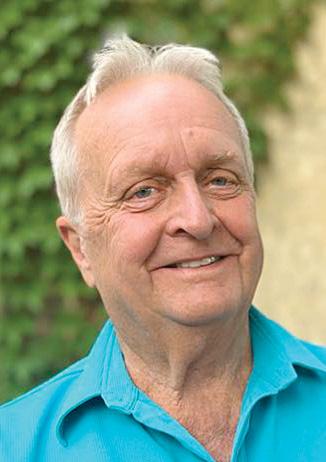
Vectors: Forces which have direction

The following story is part a new feature, the serialization of our columnist Wayne Weedon’s fictional work, Vectors. Wayne is a brilliant writer whose style consists of simple declarative statements that stick in your mind as he leads you through an intricate web of circumstances to reach the lesson he set out to teach.
Chapter 6: Family Revisited
Continued from June
When I was trying to tell Mr. Graham that I would be moving out as soon as I could find another place to live, he acted as if he never heard me. He just kept blabbing on and on like a broken record.
Finally, he paused, and then asked me, “Do you know the difference between dialogue and argument?”
“Well of course I know.”
“I don’t think so. All your life you have heard only argument. You don’t know that two people could sit down, give their opinion, and listen to the other person’s opinion without commenting.”
I tried my best to ignore him, but he continued, “When I was younger, I did not know the difference between intelligent conversation and argument. As a child I heard only argument. I heard adults arguing and arguing often. Sometimes, especially if fueled by alcohol, the argument would turn to shouting and the shouting would often turn to violence. Each person had their opinion which was mostly not based on facts. Rather than sharing opinions and information, each person had an entrenched position which, if challenged, made the person with a different opinion, their enemy.”
I was thinking, there he goes, off on another diatribe.
He asked, “Tell me now if what I just described does not pertain to your family … as well as to yourself?”
I sat silently stewing. How dare he ridicule my family? He doesn’t even know them.
He said nothing for a long time, and I thought he was finished. I was wrong, after a deep sigh, he continued in a new vein, “Next Saturday, Maurice is coming to dinner. I’d like to do something special. I know Maurice doesn’t cook for himself. I was thinking, maybe a traditional roast chicken dinner with potatoes, carrots … maybe parsnips… and gravy of course.”
I wanted to tell him to leave me out of it, I would no longer be living with him, but I just kept my mouth shut.
“Maurice and his wife were very special to me; despite the fact I’ve seen little of him since his wife died nine years ago. They had a child who died in infancy. Maurice has been alone since his wife died. Maurice’s wife was my very best friend. Maurice was somewhat jealous of our relationship, even though it was more
like a mother-son intimacy. We were intimate, you know, very intimate.”
After a brief pause, he continued, “And, to the question you want to ask, we did not have sex. It wasn’t that kind of relationship. She was my mother, my mentor, my confidant. I told her all my secrets. Eventually, Maurice came to understand that our relationship was platonic.”
I didn’t know what to think. I wondered why he was telling me all this. It was none of my business.
He continued, “After his little girl died in infancy, the doctor told them they couldn’t have another baby. It broke my heart seeing how they both yearned for a child. Maurice buried his wife’s ashes under a purple lilac bush in the garden where he found you shivering in the cold. It’s a memorial garden you know. A memorial garden not for his wife, but for a wealthy lady. That is why Maurice looks after it. He had to bury his wife’s ashes in secret. If he was allowed to, he would place a little stone or plaque where his wife’s urn is. His baby is buried in Montréal. But, in Maurice’s mind, the garden is in memory of both his wife and his child.”
He stepped out of the room. I thought that was the end of it, but he came back, handing me a picture. “She gave me this photo of herself as a young girl on the farm, eating dinner with her family. She often invited me to stay for dinner with her and Maurice. She learned her cooking skills on the farm. She cooked as if everyday was Christmas. I would like to re-create that atmosphere when Maurice comes. I want friendly conversation, along with good, homecooked food. A little nostalgia, that’s what I want.”
As Mr. Graham turned away, I could see tears in his eyes. He went to the stove and banged a few pots around before turning back. Looking at me, he quietly suggested, “We may as well finish the last book of the trilogy; before you move out.”
Mr. Graham continued reading about Ma and Pa Gall, the evil Mrs. Bridgetower, and others. I thought about what he said about my family. He had us pegged, right to a tee. He knew how I had been brought up, and he knew that I had indeed picked up my family’s habits.
I thought about my father’s new 60-inch television and how he and my brothers would be guzzling beer and wolfing down junk food while screaming over some stupid football or hockey game. Did it make any difference to their lives if their team won or lost? But, for them, their team was always the best team, even when their team was losing. And if anyone dared to disagree about their opinions, they would be in for
an argument, and, possibly a physical confrontation, especially after they had several beers.
My mother is always yapping and hollering at her television, telling all her soap opera characters how they should be living their lives, pointing out where they were going wrong. How ridiculous is that? She has never been able to run her own life, what makes her think she could give good advice to other people? She is always telling me what not to do, but, whenever I try to have a serious talk with her, to tell her my problems, she never listens to my story. She tells me I’m just going through a phase, or it is all part of growing up, and it will all work out in the end. When I tried to talk to her about my brother smoking pot, she completely ignored my comments, and started telling me about a woman she knew who smokes two packs of cigarettes a day. Several times I insisted we discuss my brother and his pot habit. It was only after much pestering, she finally acknowledged my comments, but she just sloughed them off as if they were of no importance, telling me my brother is just going through a phase and it will soon pass. However, she made it obvious that I was annoying her by jumping up and telling me she was late for an appointment and had to go.
I can’t remember my mother ever having the kindness to just listen to me. Sometimes, I just need a sounding board, but, in my family, there never is one. It seems that my parents really do not care about me and the insecurities and anguishes I’m going through. They just make light of everything and pass it all off, pretending there’s no problem.
The next morning, with a charged battery, I started checking my texts. I didn’t realize it; Mr. Graham was looking over my shoulder. He asked me what all the gobbledygook was. This made me feel good. I could finally teach him something for a change. I began translating the texts for him. Sheila had been constipated for several days and she just had a good poop. Mavis’ mom made pizza and she tried to hide Niblets under the cheese. Tony got wasted and threw up on his girlfriend’s new bedspread.
Mr. Graham interrupted and asked if there was anything important because I needed to work on vectors. I was about to tell him it was all important; but somehow, just then, all these texts seemed quite stupid. Why was I wasting my time reading such crap? I shut the phone off and started working with Mr. Graham on forces which have direction.
Continued next month: Chapter 7, All's Well that Ends Well
August 2023 whatsupwinnipeg.ca 13
Raymond Chandler. Photographer uncredited. Published by Alfred A. Knopf.
Jim Ingebrigtsen
Gala in the Garden
A perfect summer soirée under the stars
Who doesn't love an evening in a beautiful place for a good cause? Exactly. That is why you should get your tickets to this year's Gala in the Garden on Aug. 26 at the International Peace Garden!
After three arduous years of pandemic related closures and restrictions, the IPG is ready to celebrate another incredible summer with an evening of food, drink, flowers and giving.
Guests to this year's Gala will get a glimpse of the continued work on the expanded Conservatory, which is home to the world's most diverse indoor collection of cacti and succulents. You read that correctly. Manitoba and North Dakota have one of world's most impressive collections of plants, let along arid plants from all corners of the globe.
Thanks to the support of Manitoba and North Dakota, the Garden embarked on a project of nearly
$10M CAD to give the collection and its visitors a more proper home.
The home includes the outdoor surrounding spaces that we continue to raise funds for. Adjoining the building are outdoor raised beds that will house the hardy collection of the late Ernie Brown aka Dr. Cacti of Winnipeg.
Thanks to people like Mr. Brown and the primary collects Don Vitko, of Minot, North Dakota, the Peace Garden continues to expand its beautiful offerings for students, researchers, communities, families, and businesses seeking a most unique place to host their events and conferences.


These prickly, colourful plants will be celebrated at the Gala as attendees don summery, semi-formal attire. Guests will stroll through the ever-changing Sunken Garden with a kaleidoscope of colour peeking around each pathway.
Great food, entertainment and auctions await for a good cause. The Garden is fortunate to be surrounded by such great support and warmth of Manitobans and North Dakotans. Our governments have stepped up to help fund our growth and we hope you will join them to support one the most unique and special institutions in all of Canada and the US.
For $875, you and your friends, family and colleagues can purchase a table for 8. Individuals can purchase their tickets for $125. Unable to attend, the Garden is also accepting sponsorships, pre-auction donations and auction items.
If you'd like to spend the night and enjoy the surrounding Turtle Mountain area on Sunday, hotel accommodation information is available on our website.
Tim Chapman is the CEO at the International Peace Garden on the border of Manitoba and North Dakota. The Garden is open year-round and grooming ski trails for the first time this winter. Rent one of our cabins and enjoy a winter weekend that only the forest of the Turtle Mountains can provide.
Family weddings and best wishes

My household is just emerging from the very interesting experience of hosting a family wedding in mid-July. The process of planning, the joys of selecting and contracting vendors, picking flowers, meals, dresses, invitations, locations, bridal party members, rings, suits, gowns, hotels, officiants, musicians, caterers, and honeymoon locations is quite onerous. This does not even include the official processes for ensuring a legal wedding in Manitoba and the vows and wedding service itself. In an era of “Say Yes to the Dress” and much emphasis on the importance of the special day for the bride and groom, it can all become of a three-ring circus.
We had the unfortunate experience of two major illnesses in the family in the weeks before the wedding that, while completely devastating, somehow forced us to focus on the important parts of gathering to bless a couple as they commit to a life together. We experience joy and sorrow in tandem at times, and perhaps it is necessary for us to fully appreciate the central role of people in our families rather than obsessing about the exact shade of the bridesmaid gown dresses or tablecloths.
We gather the people we love to share in these sacred moments of commitment and joy in establishing household units in the next generation. For those of us of the older generations, we have best wishes for the young couple in their lives together. This, too, is important. What have we learned about the joys of sharing a life with someone that we would also hope to see our young family members experience?
I have identified several items that are important to me and that I hope my daughter and her new husband
Etch-A-Sketch
The Etch-A-Sketch was probably the first interactive, handheld, screened device. It was not palm-sized but was still easily held in two hands, although I usually used mine while it was resting on the table. While it was a cool invention and I did spend a lot of time with it, the EtchA-Sketch had a design flaw.
Sometimes, the columns I write go directly from my thoughts onto the paper. Sometimes, the words seem to bunch up at the end of my pen and the column takes longer to write. This column was two years in the making. By the time this story is published, it will be two years since I stopped drinking. Two years of choosing not to drink. Two years seem like a long time, but if my math is right that is only about 4% of my adult life. Two years seem like a short time, but if my math is right that is 100% of my new life.
Rick Duerksen Reach
experience in their marriage.
1. I hope that they will truly enjoy the journey of your shared life knowing that the adventures and lessons along the way are the real point of the union, not some perfect destination.
2. That they will continue to value the community of friends and family members who will share in their laughter, adventures, board games, and holiday celebrations.

3. That they will live their lives with generosity toward others and their community. That they will live well within their financial means so that they always have resources to share with those who are less fortunate and the organizations and causes that are important to creating the kinds of communities in which we want to live.
4. That they will genuinely celebrate each other’s successes and share the burdens in difficult times.
5. That the special light of kindness and love that so clearly exists between the two individuals on the wedding day will continue to grow and bless their lives for the decades to come.
6. That they will protect each other from heart ache and sorrow to the extent that is possible knowing that our time together is short, and we can make a huge difference in the lives of those we love by small daily kindnesses.
A semblance of order is returning to our home in Winnipeg, but memories of a wonderful celebration will be with us for many years to come.
Trudy Schroeder provides project planning and management services to the community through Arts and Heritage Solutions.

I remember distinctly the moment when I decided that I had had enough. I was tired of the effort it took to continue to drink, and I was tired of waiting to die. I was sick and I was tired. Sick of being tired. Tired of being sick. When I am asked how it has been, if it has been a struggle, I say that at times, choosing not to drink has been the easiest difficult thing I’ve ever done and that at times it has been the most difficult easy thing I’ve ever done. For the most part, though, it is just a choice I’ve made. A choice I am able to live with. A choice I could not live without.
I think of all the people who have contributed, in some way, to my new life. People who unselfishly gave me the gifts that have helped me. I think of how they would feel if I were to fail. Some would be sad. Some would be hurt, and some would be justifiably angry. I think about
how much it would hurt me if I let them down. But I don’t continue to choose not to drink for them. I do it only for myself. In this one thing only, I am totally selfish. I like my new life and I will do whatever it takes to protect it. If other people benefit from that, that is a bonus. But I choose not to drink for my own benefit, first. There were a lot of things that led me to where I was that August morning, two years ago. Some were the result of what I did, and some were the result of things completely out of my control. But how I did react to those situations and what I did in response were my choices. My decisions.
The problem with an Etch-A-Sketch is that once a line is drawn, it can’t be undrawn. No matter how carefully you retrace a line, it stays on the screen. I look at all the lines on my Etch-A-Sketch of life that draw a picture I am not proud of. Lines that I can’t undraw. Lines I wouldn’t undraw, even if I could. If any part of my past was changed, if a line was undrawn and a new one was etched onto the screen in its place? It would change the picture, but it wouldn’t guarantee a better picture.
I don’t know where I’d be if anything in my past was changed, but I know where I am today. I know that I am where I am because of my past, not in spite of it. I like where I am today, and I am where I am because of the choices I have made. I have everything I need and even a few things that I want. I am content.
Tonight, before I go to sleep, I’ll look at what I drew on today’s Etch-A-Sketch of life. Whatever is on the screen might as well be etched in stone. I couldn’t change it, even if I wanted to. So, I’ll put down the Etch-A-Sketch and fall asleep. When I wake up, it will be there, waiting for me to pick it up. But during the night, the Etch-A-Sketch will have been picked up, turned upside down, and shaken. I’ll be given the day’s Etch-A-Sketch and it will have a blank screen. I can draw anything I want. I don’t know if I’ll move the cursor up or down, left or right, or maybe a combination of moves. I won’t know where the cursor is, but I won’t make a small, tentative move, trying to find out where it is. I’ll make a bold move and start drawing. I will start drawing another beautiful day.
14 whatsupwinnipeg.ca August 2023
Tim Chapman
Trudy Schroeder Random Notes
Basil, the beautiful herb
Basil was on steroids in some areas of the country last summer. The regular big-leafed variety, the common Ocimum basilicum, grew into shrubs with the warmth of the early summer. Maybe that is not surprising, since they hale from Central Africa and South East Asia where basil is perennial and grows anywhere from one foot to almost five feet tall!
Here in the north, though, it is an annual — it really hates getting a chill and any sign of frost kills it – and while it seldom grows to the heights of this summer, it is friendly to indoor spaces as long as there is enough light.
Growers worry about it bolting – flowering and going to seed – but here is a little secret: only the stalk that flowers turns woody and stops sending that lovely oil to its leaves. You can allow one or two stalks to go all the way to seed while still harvesting the tender leaves of the unflowering stems. You can also pinch out flowers at the first sign of their emergence.
Here’s another secret: you can easily propagate basil from cuttings. A couple of weeks in some water and roots will emerge. A little rooting compound will speed things up. (Some people add a single regular aspirin to a gallon of water to hasten rooting). Cuttings should be between three to six inches and have several branch nodes. Remove all but the top four to six leaves. Plant the cutting up when the roots are well established. Basil loves the outdoors, but will do just fine indoors
6 basil varieties and their properties
Sweet basil. This sweetest of the basils, it is the one most likely to be found at your local grocery.
Sweet Thai basil. Small, dark pointed leaves, it keeps it flavour at higher cooking temperatures.
Purple basil. Dark burgundy coloured leaves with a stronger clove-like taste. Often steeped in vinegar or oil.
Lemon basil. Smooth, medium-sized, light green leaves.
Wonderful aroma. Great for fish grilled vegetables.
Lettuce Basil. Crinkly leaves, good in salads. Mild in flavour. Sometimes used as a wrap.
Spicy globe basil. Small leaves in a mounded bush form. Strong, spicy odour and flavour. Use in soups and pasta. This is just a few of the many varieties available.
as long as you provide enough light – a sunny window, or with a grow light. You can also collect the seeds and plant them next year, either starting them indoors about six weeks before the last frost or planting seed directly into soil after all danger of frost has passed.
Seeds take about 14 days to germinate and for the cotyledons to emerge. Two to three weeks later, they should be six inches tall. If you want early basil, start the plants indoors or buy plugs from the local garden centre. It is a good idea to start plants a few weeks apart to ensure you always have tender young leaves to pick
My all-time favourite animal
for your fresh summer salads, pesto or other culinary delights.
Regular, well aerated soils with good drainage are all you need. And if basil dries out and leaves wilt, it is useful to know that you can rehydrate the plant. Water it heavily and it will recover. Here is a time lapse video of the process. https://www.youtube.com/ watch?v=t4RkOgcwWsg.
There are many types and varieties of basil as you can see in the sidebar. An interesting variety is Holy basil (Ocimum sanctum), which is called Tulsi in Hindu. It shows its relationship to the mint family with its serrated leaves and square, red stems (it can also have purple leaves). It is spicy, sweet and is used in teas and medicines as well as in cooking. In Hinduism, the herb is sacred to the goddess, Tulsi, and offers protection. Hindu families often have a plant growing in their homes. It is said to help ulcers, joint pain and reduce stress.
When cooking with basil, add the leaves at the end of the cooking process. The sweet basils mostly lose their flavour at high temperatures. To preserve basil, it can be frozen. Drying is not very successful – makes it taste like hay!
If you have engaged in the old pronunciation wars about whether to say Bah-sil or Bay-zil, be advised that both are correct. The British usually say the word with the short “a” and Americans with the long “a”. As usual, Canadians are just confused.
Robert E. Wrigley
While I was employed as the Curator of the Assiniboine Park Zoo, one question I was asked repeatedly while giving talks or leading tours was; “What is your favourite animal?” Without a doubt, my choice was the Snow Leopard, and in particular, our magnificent male, Dmitri. He was an exceptional animal both physically and in his aristocratic mannerisms. Built for speed and powerful leaps, he moved with the grace of a fast-flowing stream, never suffering an awkward step or momentary loss of balance. His regal persona stopped visitors in their tracks, and the intensity of his glare was arresting, capable of sending chills down a visitor’s neck. Dmitri was a fine-tuned predator, truly a product of millions of years of evolution in a world of deep snow, howling winds, and rocky mountainsides so steep that one slip meant almost certain death.
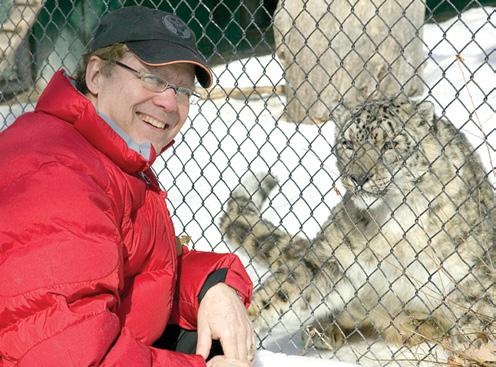
I once watched a television show narrated by the famous naturalist-broadcaster David Attenborough in which a female Snow Leopard was filmed in a death-defying pursuit of a markhor (a large species of wild goat) down a near-vertical mountain slope in Pakistan. It was one of the most-dramatic, predator-prey chases I have ever seen. The leopard managed to maintain its balance after semi-controlled falling for many metres in each bound, landing on broken rock and absorbing the great force of gravity with its muscular limbs acting as shock absorbers. Its reckless speed demonstrated a precision of eye-brain-body coordination which was hard to comprehend in real time, and any miscalculation in a procession of rapid decisions would have resulted in a fatal fall for hundreds of metres onto sharp-edged boulders. At the end of this scene, the markhor escaped by tumbling into a raging river. In the next attack se-



quence with another markhor, the leopard was successful, and with super-feline strength dragged its heavy prey back up the slope for a kilometer to reach its den, where its cub was waiting for food. How the photographer managed to capture such action of one of the world’s mostsecretive big cats was amazing. Since Dmitri’s enclosure was close to my office, I could not resist visiting him almost daily, and soon we developed a special bond. This was likely stimulated by a spray of his favourite perfume –men’s Bvlgari. On each occasion, Dmitri curled up his nose and lips, began to salivate profusely, and then repeatedly rubbed his cheek and shoulder with force against the fence wire right beside me, while uttering little enduring ‘puff-puff’ calls, and then finally rolling over onto his back, as if he wanted me to scratch his tummy. I used the long antenna of my radio to tickle him (through the fence wire), and it was obvious he did not want me to stop. When I backed away to leave, he leapt instantly to his feet, and placing his front paws high onto the chain-link fence, he executed the powerful stretching movements of sharpening his impressive claws. In fact, he applied such pressure that sometimes pieces of his claws snapped off and flew through the air, something I obviously did not want to encourage. The fragrance turned him into a big kitten, every time!
Dmitri and I shared a special game, which I liked to spring on admiring visitors standing along the enclosure’s barrier fence. As I approached his exhibit, Dmitri suddenly spotted me, although I was sometimes up to 50 metres away. Transforming instantly from a bored, recumbent slouch into to an energized athlete, he crouched and crept over to hide behind a large boulder, usually leaving his exceptionally long tail exposed and twitching, evidence of his great excitement. Then slowly, the top of his head (with ears flattened) and his big eyes appeared just above the boulder, watching
intently my every move. I walked towards him, making no eye contact and giving no indication I was aware he was there. He saw right past the visitors, ignoring them completely. In fact, he was hunting me! As I drew near, I turned sharply and began to walk away, which was his signal to initiate an ambush. With astonishing speed, Dmitri covered the length of the exhibit in only two bounds and then leapt almost 3 metres to the top wall of the enclosure, striking the chain-link wire with all his weight, and causing the gravel stuck between his toes to hit me in the back of my head. All the visitors jumped back in shock, as the unexpected attack happened so fast. As Dmitri sneaked back behind the boulder for round two, I calmed the visitors by explaining who I was, and that this was just a game we liked to play for behavioural enrichment (on both our parts), but it also presented such a dramatic demonstration of his extraordinary predatory prowess.
Dmitri was a superlative representative of his race in another way. He and his mate, Lhasa, were incredibly compatible, a most-unusual trait for Snow Leopards, as they prefer to live alone (both in the wild and in captivity), except for a brief period during the breeding season. While most zoos have had no or limited success breeding this species, our pair raised an amazing 16 surviving offspring over the years – a tremendous contribution to the captive population in facilities around the world. When we submitted our annual report on the status of our collection of Snow Leopards for the Species Survival Program (operated by the American Association of Zoos and Aquariums for endangered species), the coordinator informed me that we must have erred, because we reported that Dmitri had bred his mate successfully at age 19 –several years beyond the known limit for the species. But no, there was no mistake; Dmitri and Lhasa were really this extraordinary. He lived for three ad-
ditional years, a respectful age for any big cat. Dmitri’s name was based on the ancient Greek word, Demetrios, meaning ‘devoted to Demeter,’ the Goddess of Fertility and the Cycle of Life, and so considering his compatibility and devotion to Lhasa, this name fitted him perfectly.
I missed Dmitri so much after he died that I commissioned an artist friend to paint his accurate portrait from photographs, which now hangs in my family room. I will always remember kneeling down in front of him, with only half a metre separating us through the enclosure wire, as we searched each other’s eyes and facial expressions for minutes at a time. What was he thinking behind those huge, expressive, greenish-yellow eyes? It was as if I could peer into the distant past of his race in the mountains of Central Asia, tragically now on the verge of extinction. Here was one of Nature’s premier killing machines, appearing to gain immense pleasure just from my presence. It was a truly humbling and emotional moment, which I will forever treasure. My wonderful Dmitri; my favourite animal.
One of 230 real-life stories from Dr. Wrigley’s book; “Chasing Nature: An Ecologist’s Lifetime of Adventures and Observations.”
Available for $36 by contacting robertwrigley@mts.net


August 2023 whatsupwinnipeg.ca 15
Dmitri was the epitome of beauty, grace and power. Photo by Robert Taylor.
Robert and Dmitri enjoying each other’s company. Photo by Darlene Stack.
Robert and Dmitri playing their ambush game. Art by Rob Gillespie.
Lhasa with two of her subadult cubs. Photo by Robert Taylor.









16 whatsupwinnipeg.ca August 2023 Follow us on social media and find out what we’re up to! Find out more at www.localgardener.net Local Gardener Canada’s Check out the new weekly gardening E-digest from Canada’s Local Gardener magazine! Find out more at www.localgardener.net/flora-and-fauna A harvest of wonders from Canada’s Local Gardener! The Official English Language Magazine of




































































